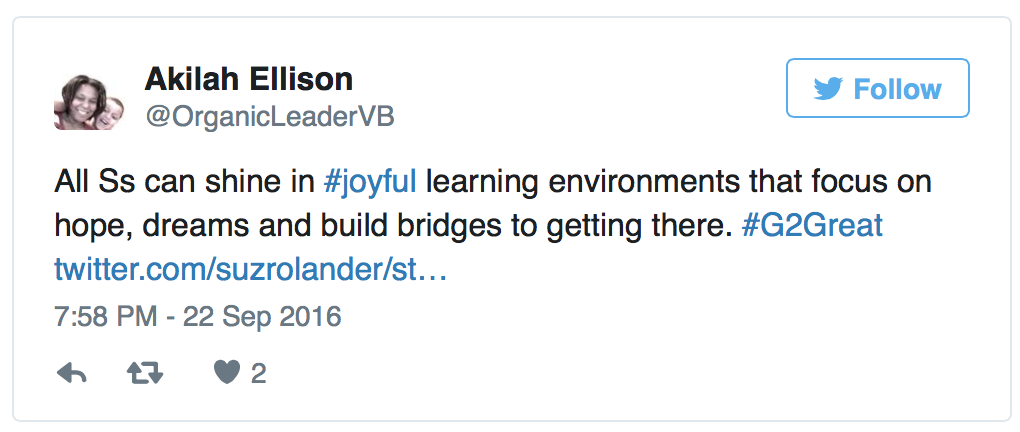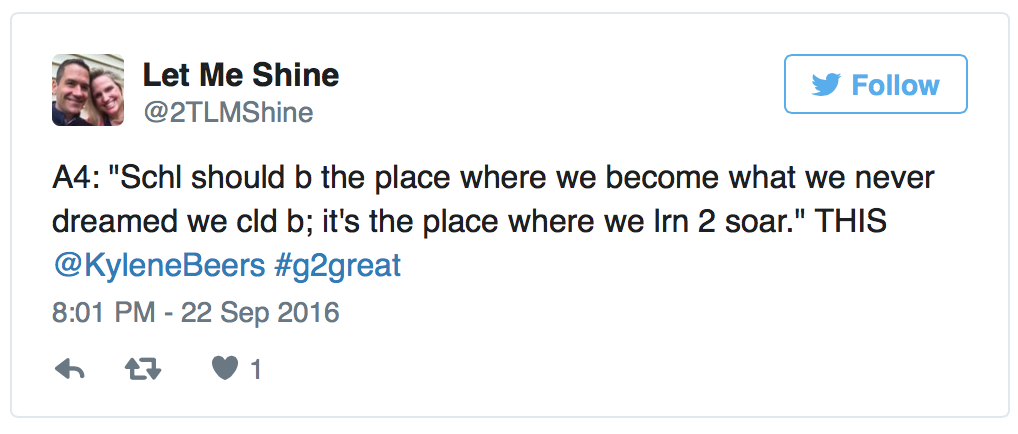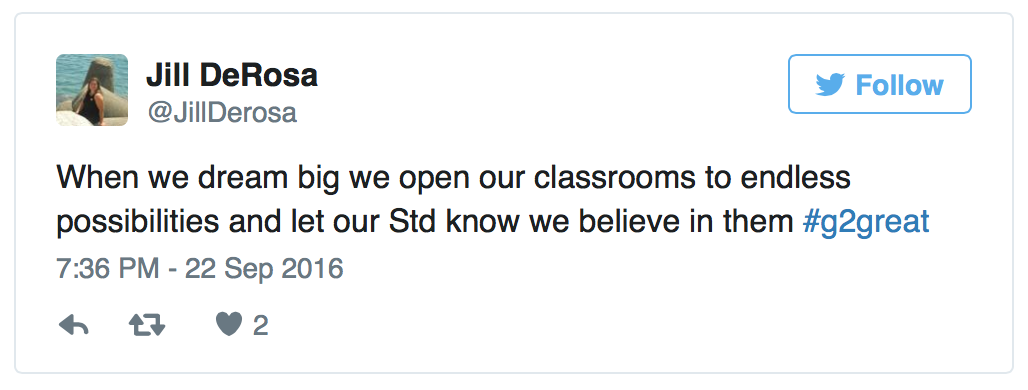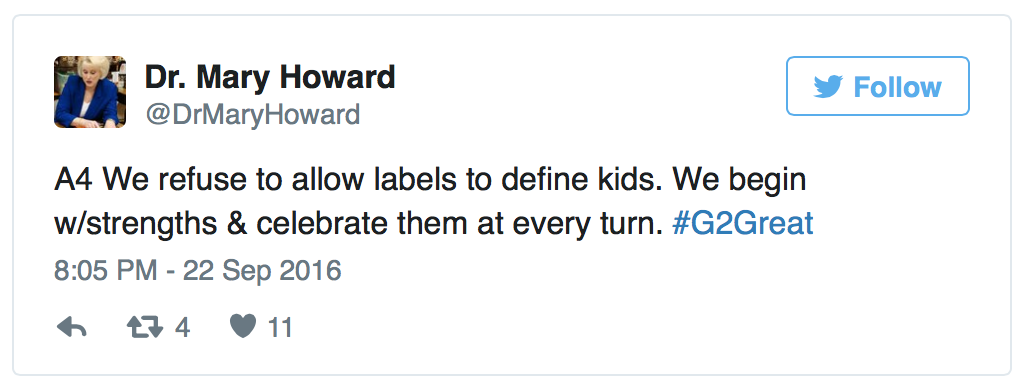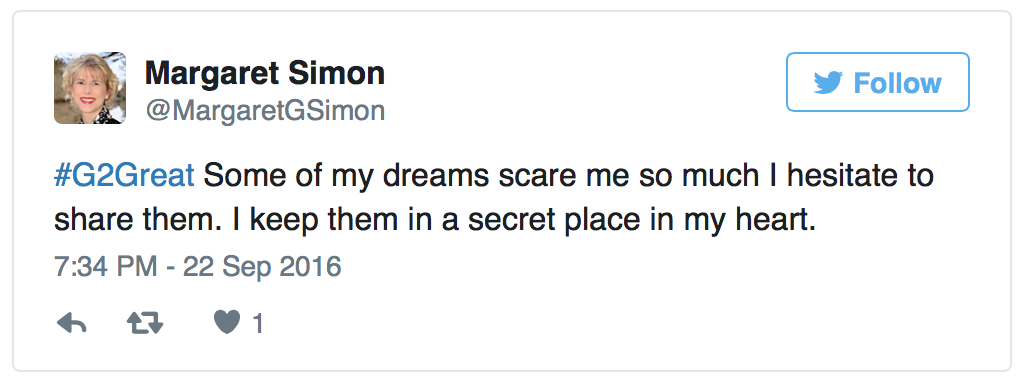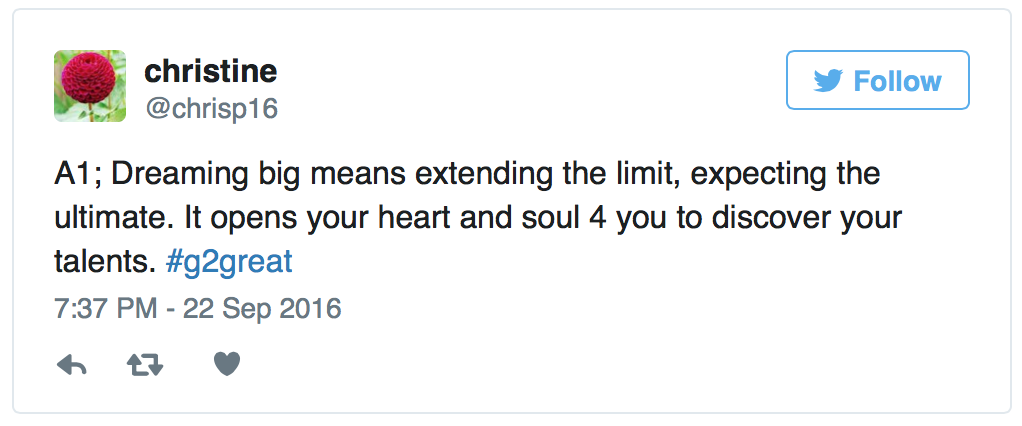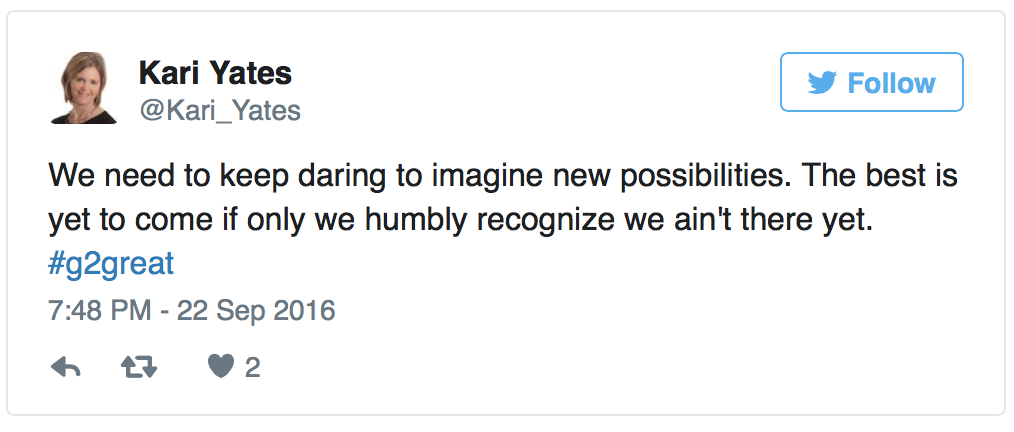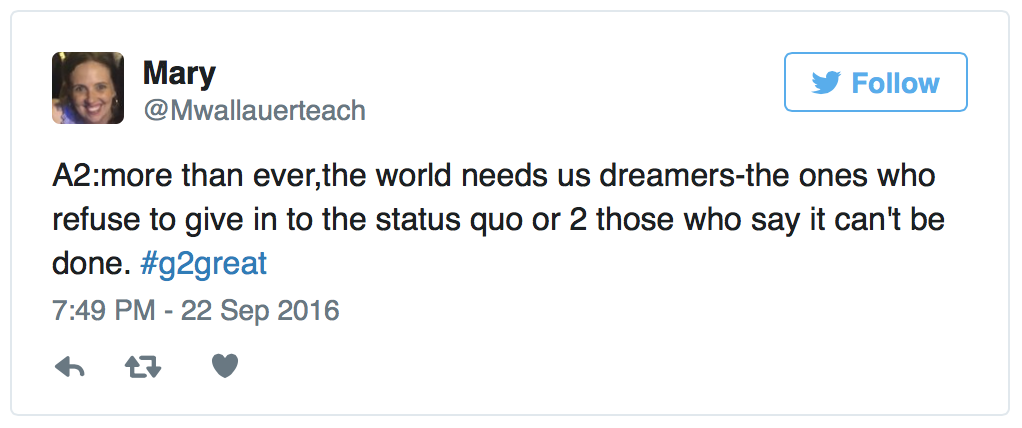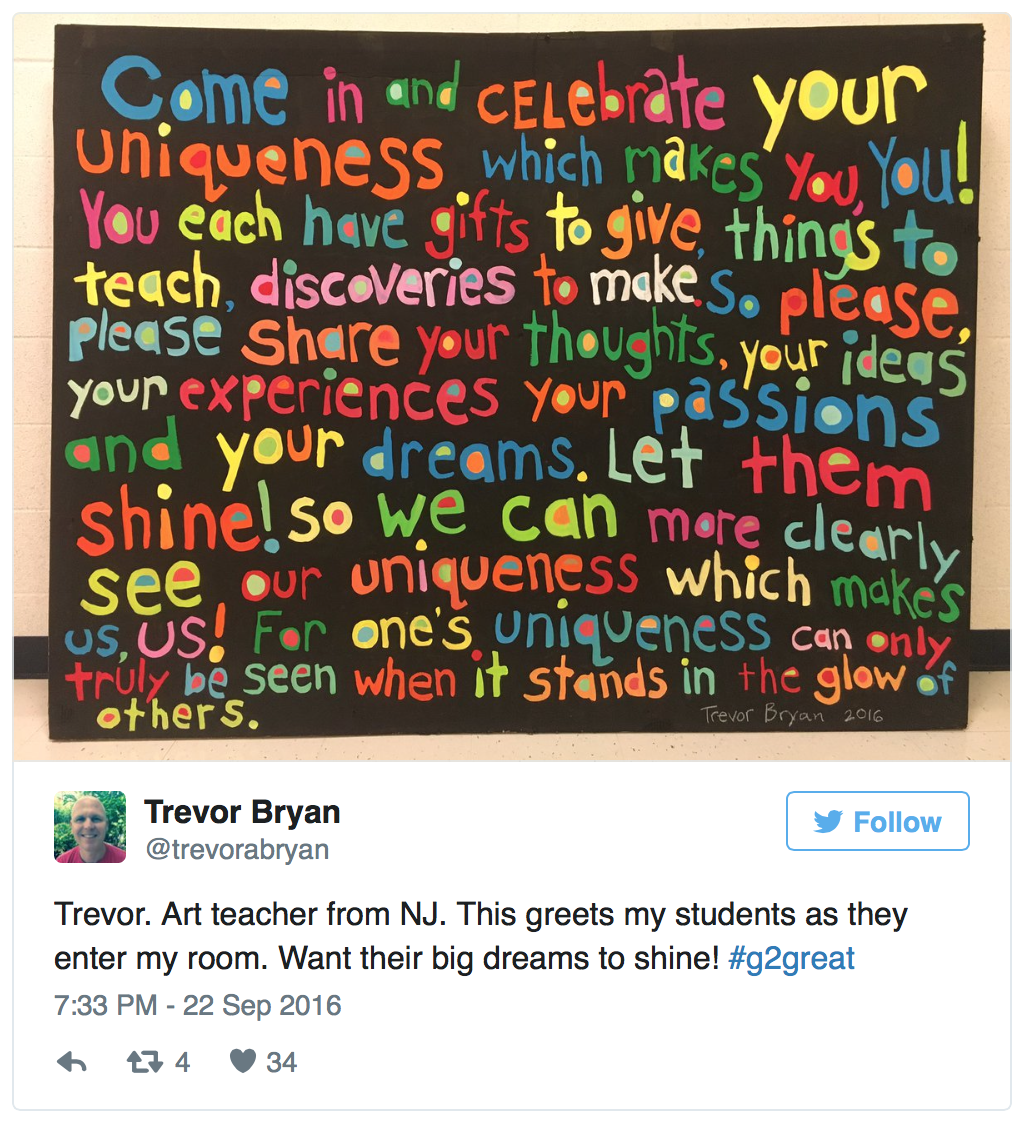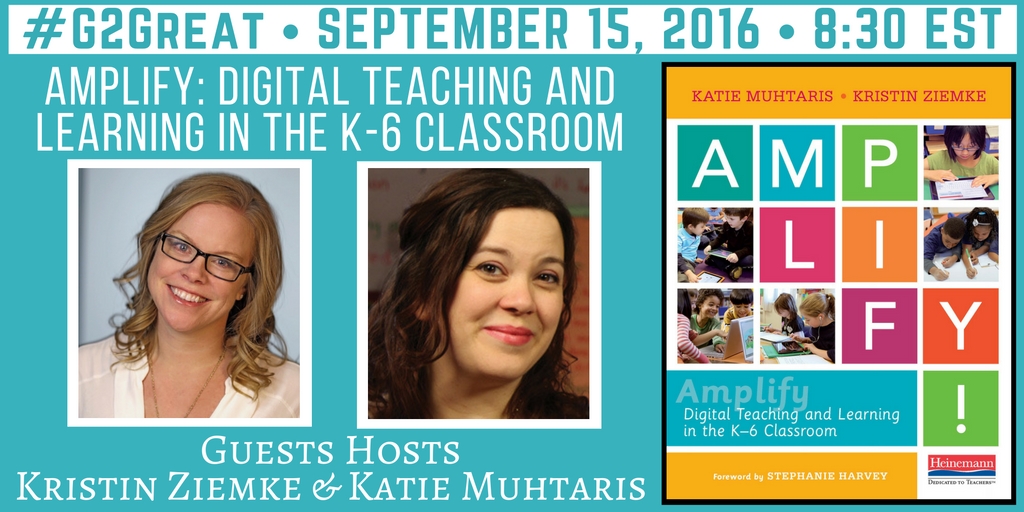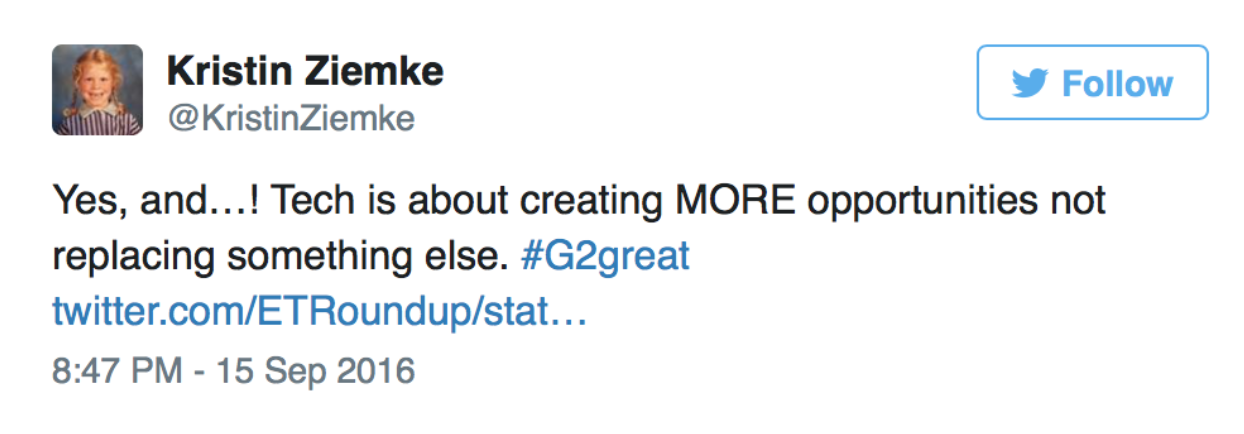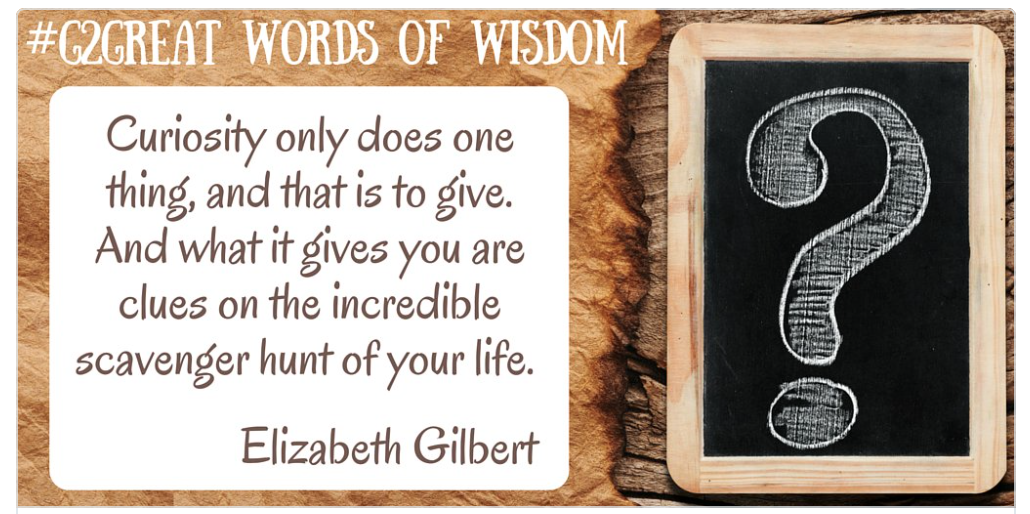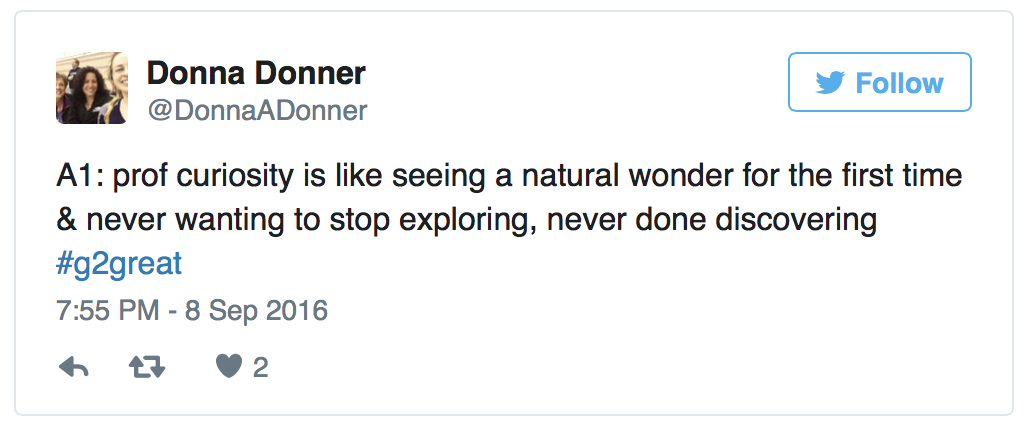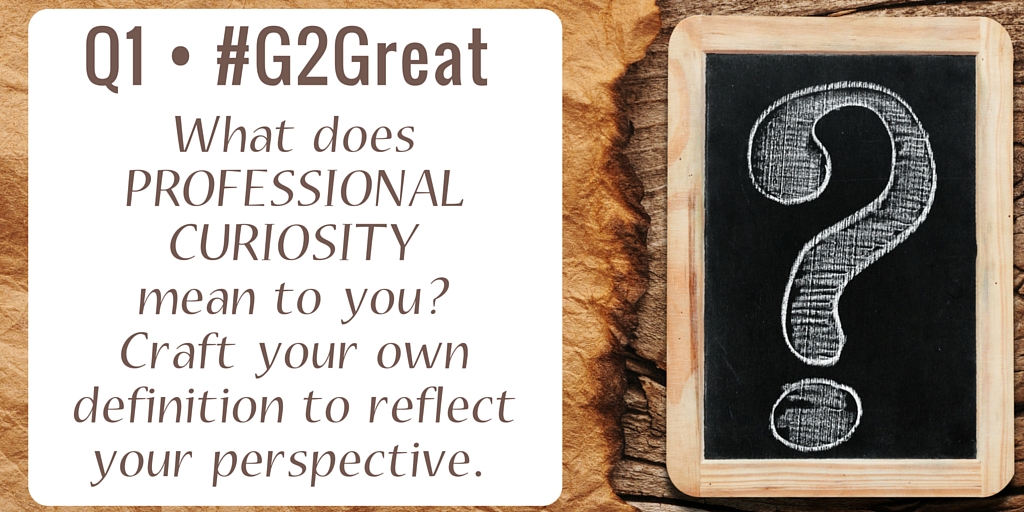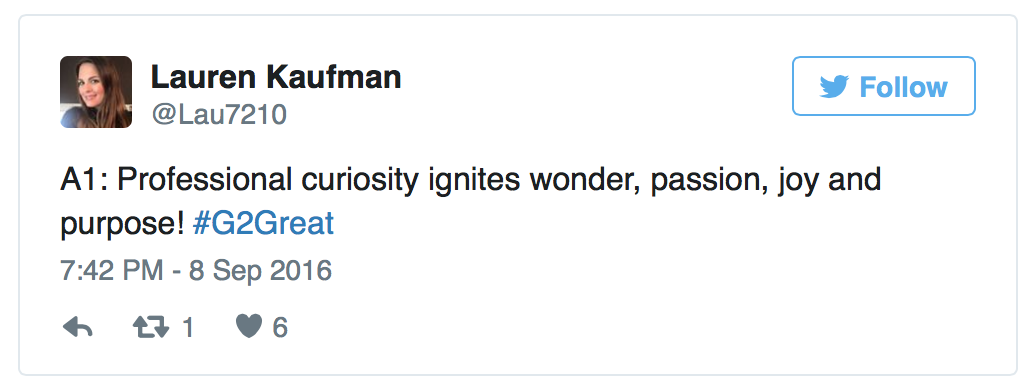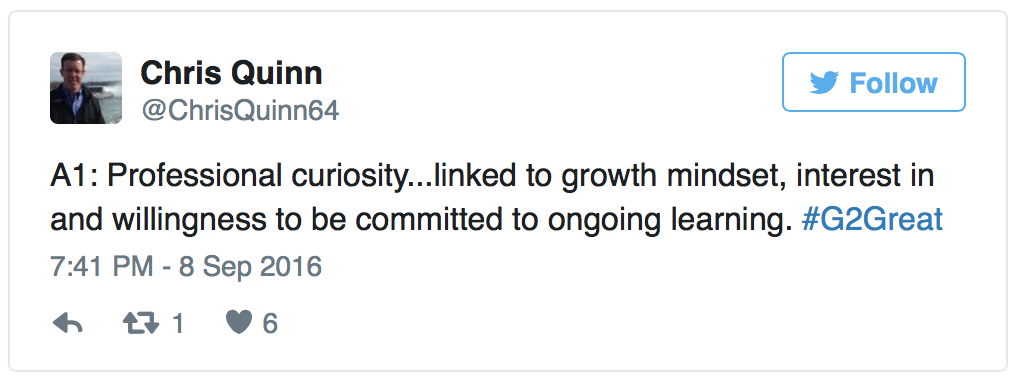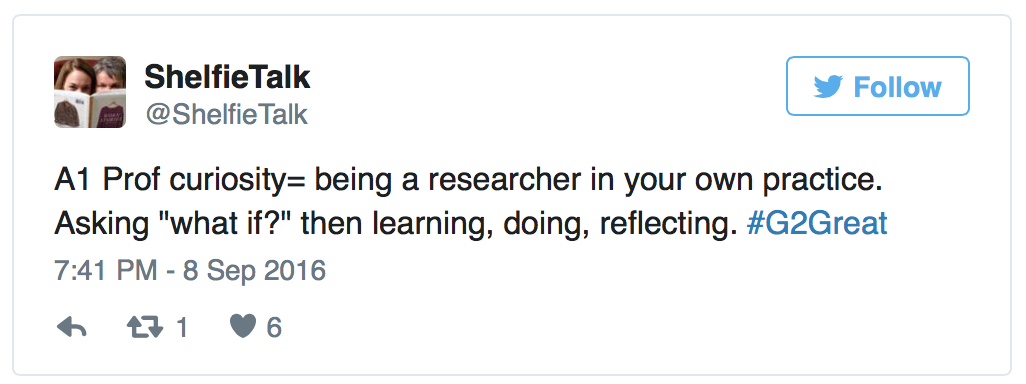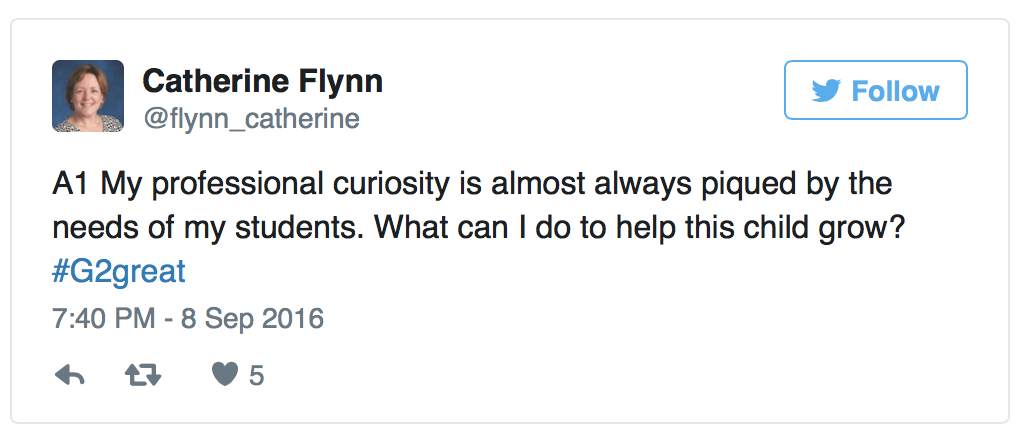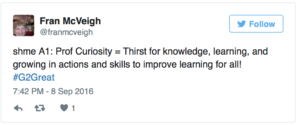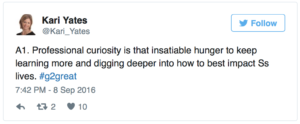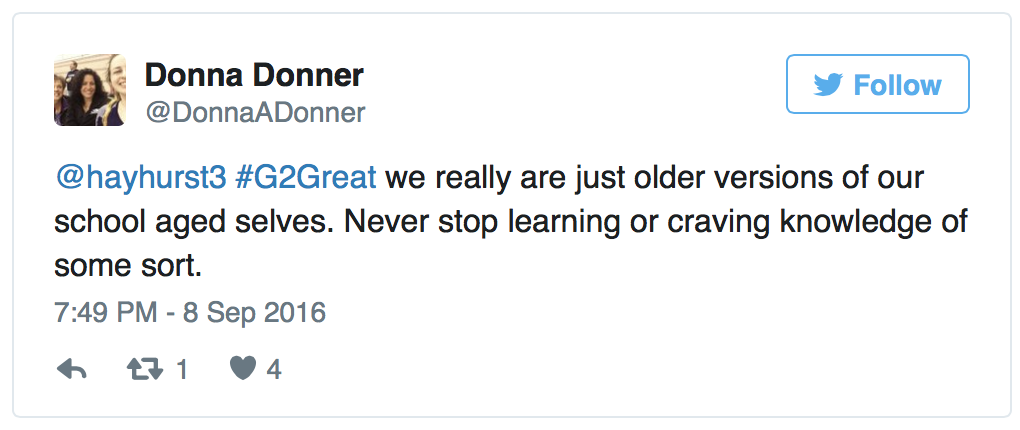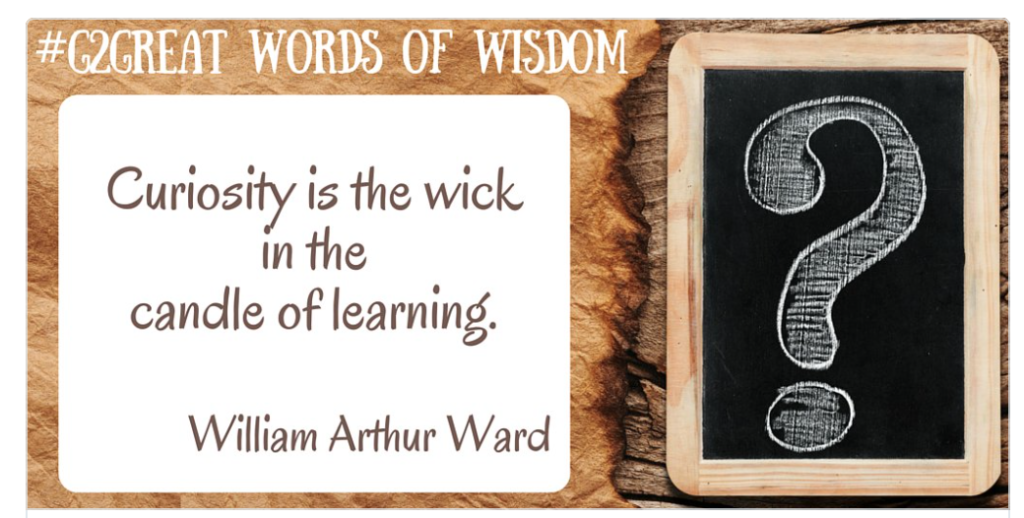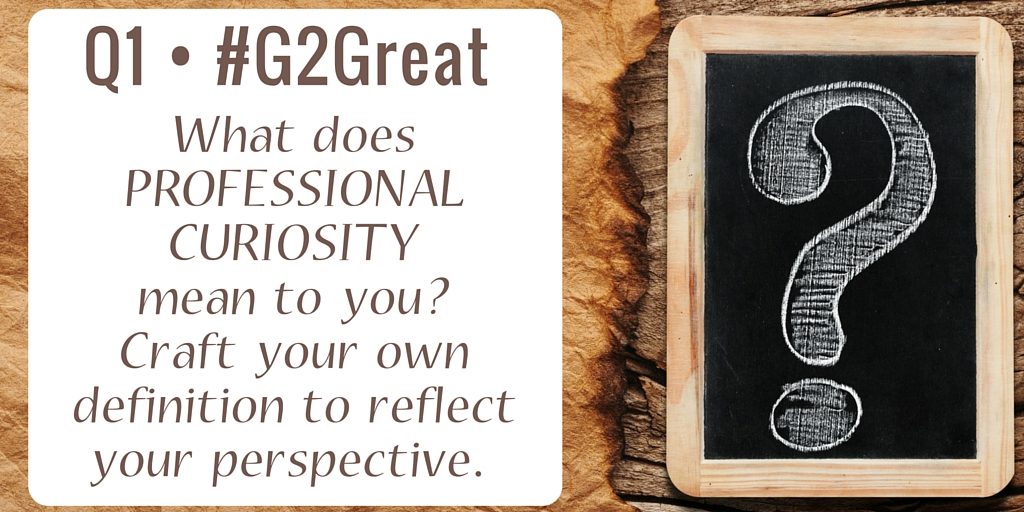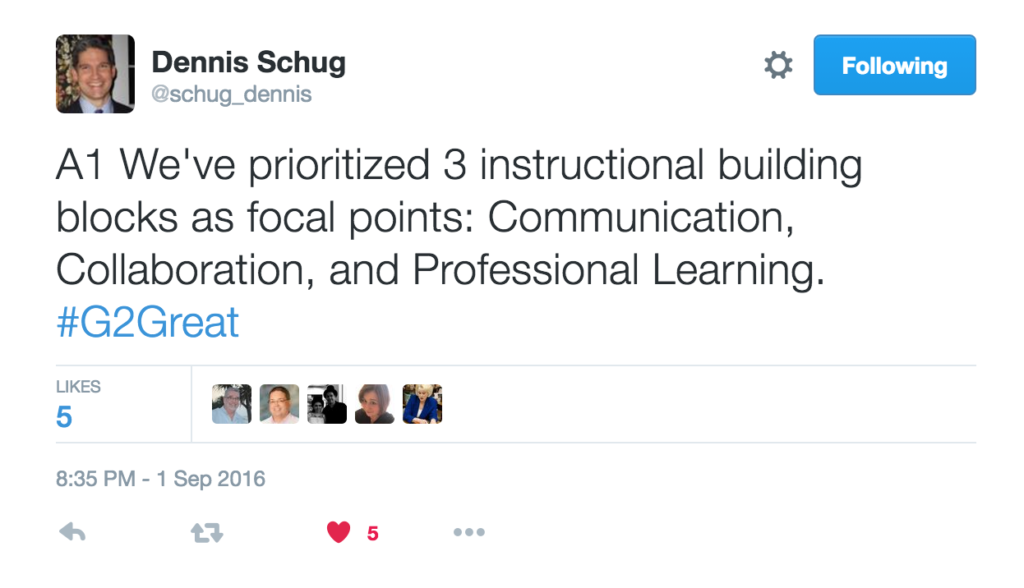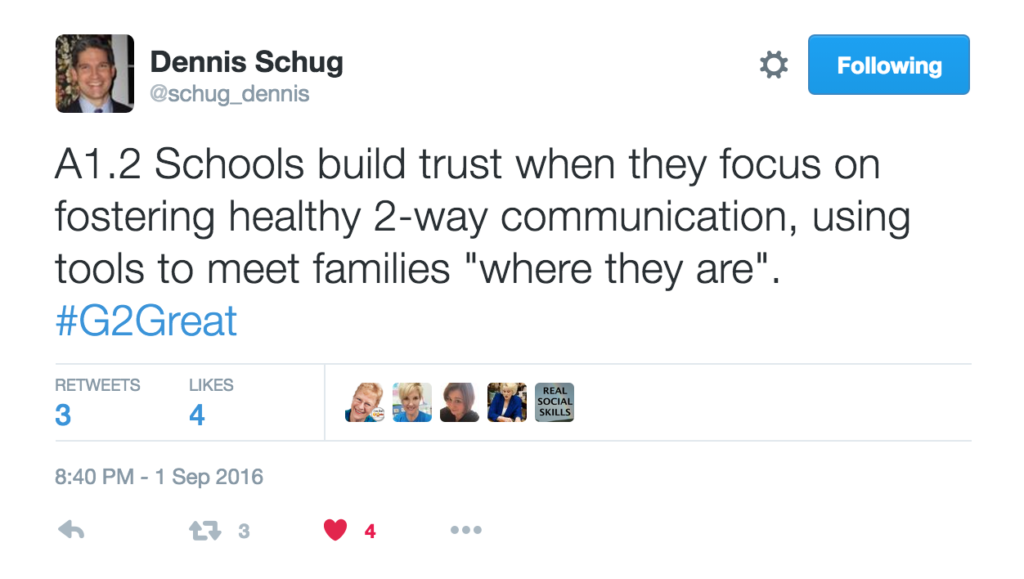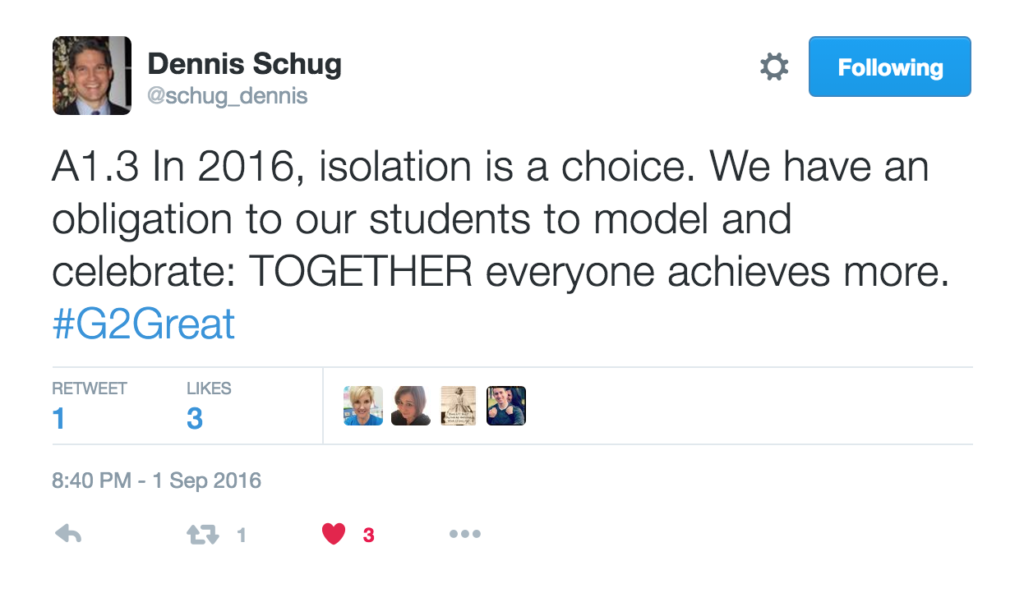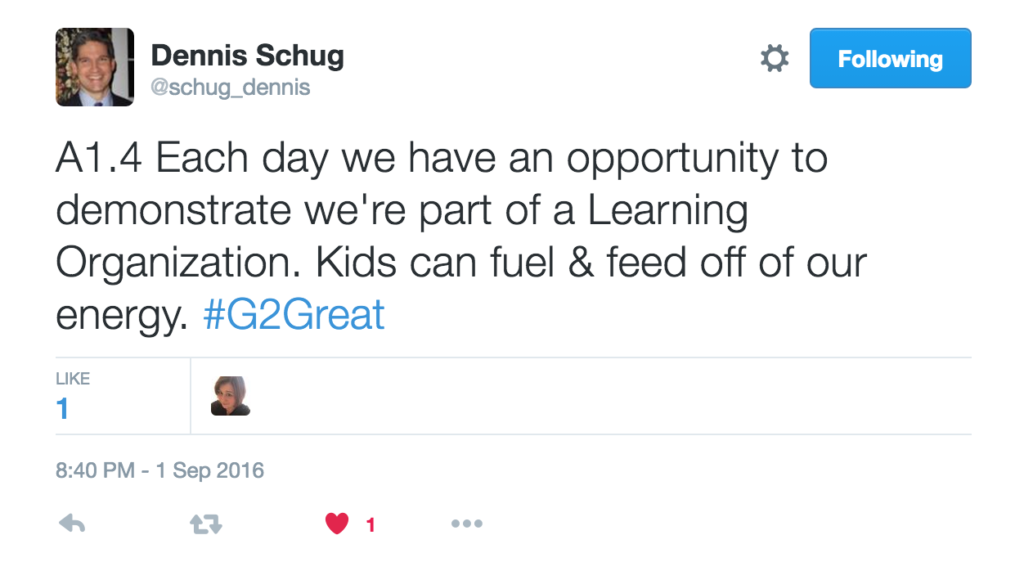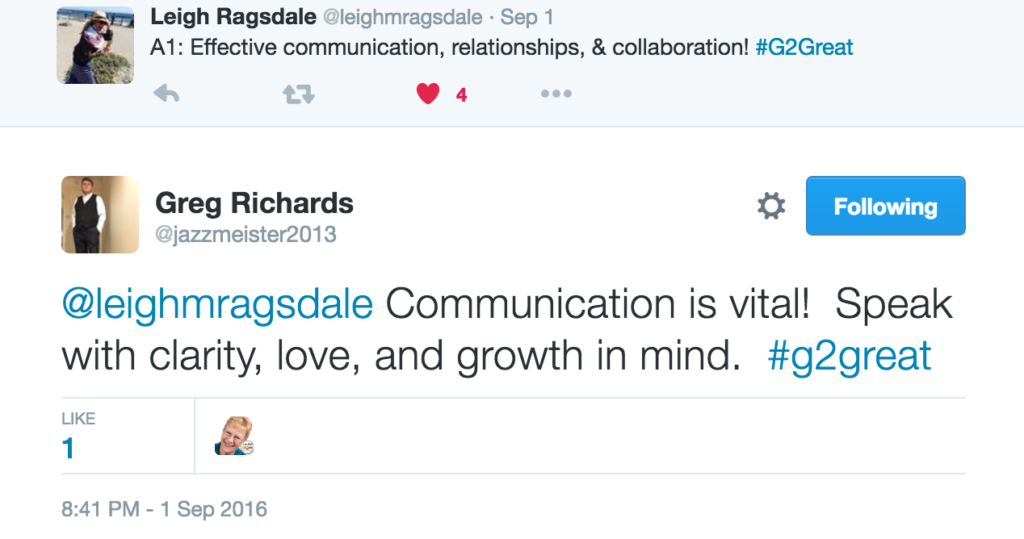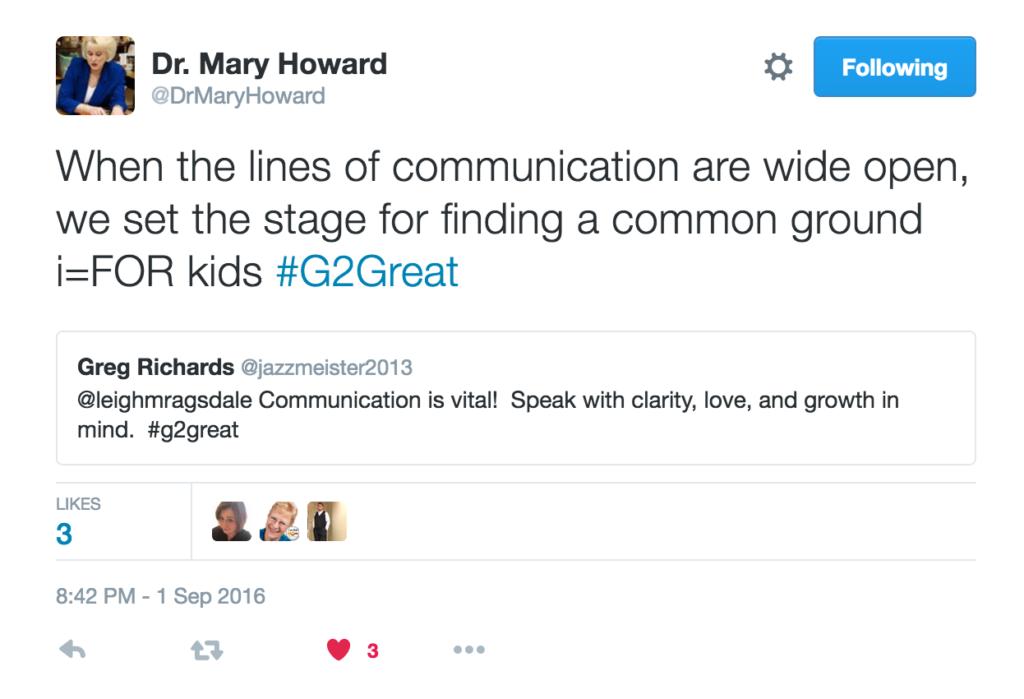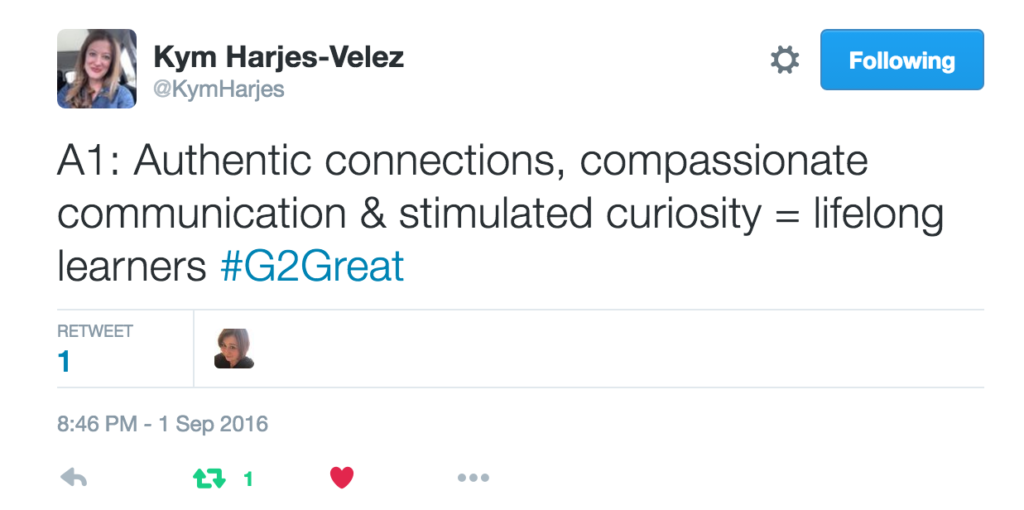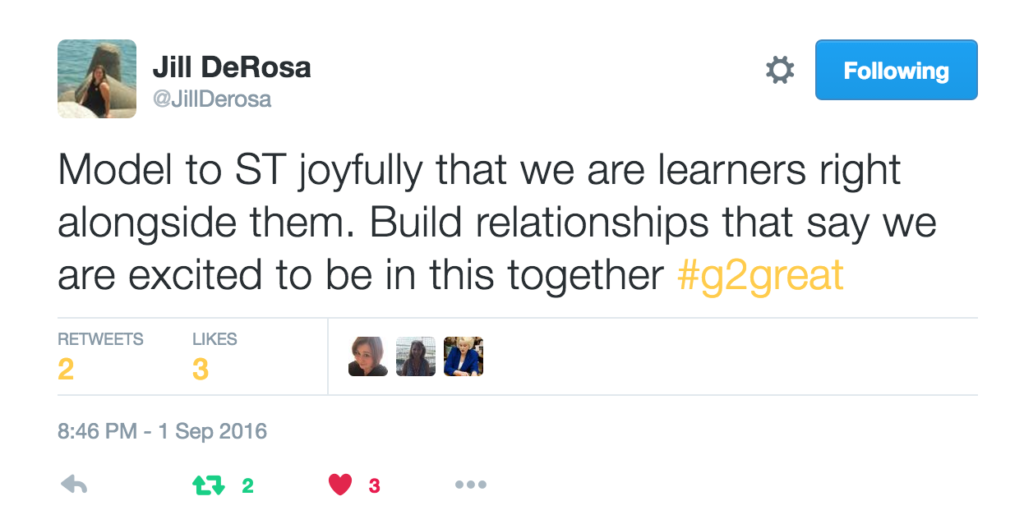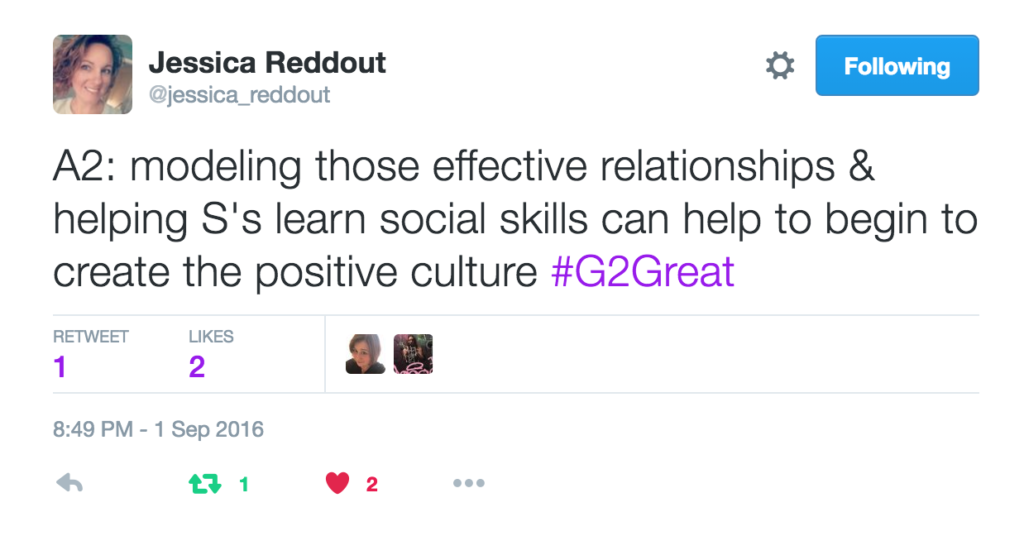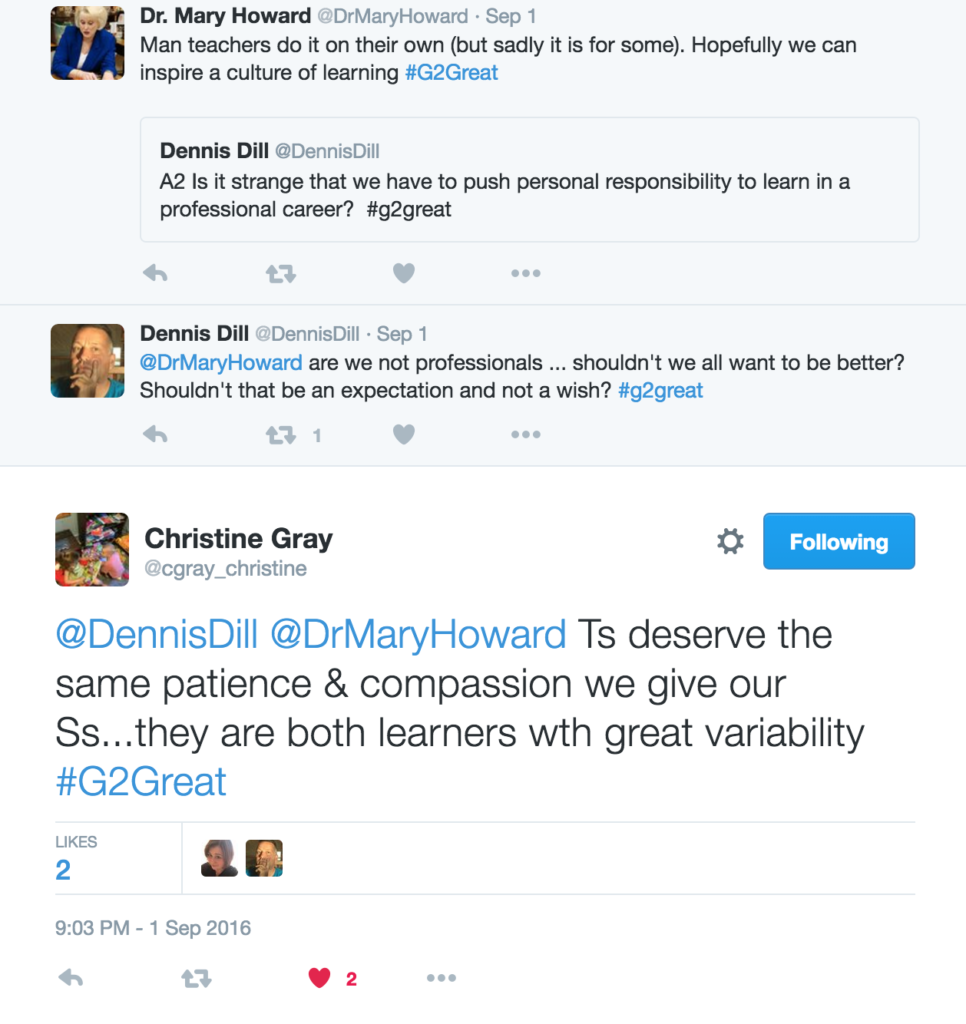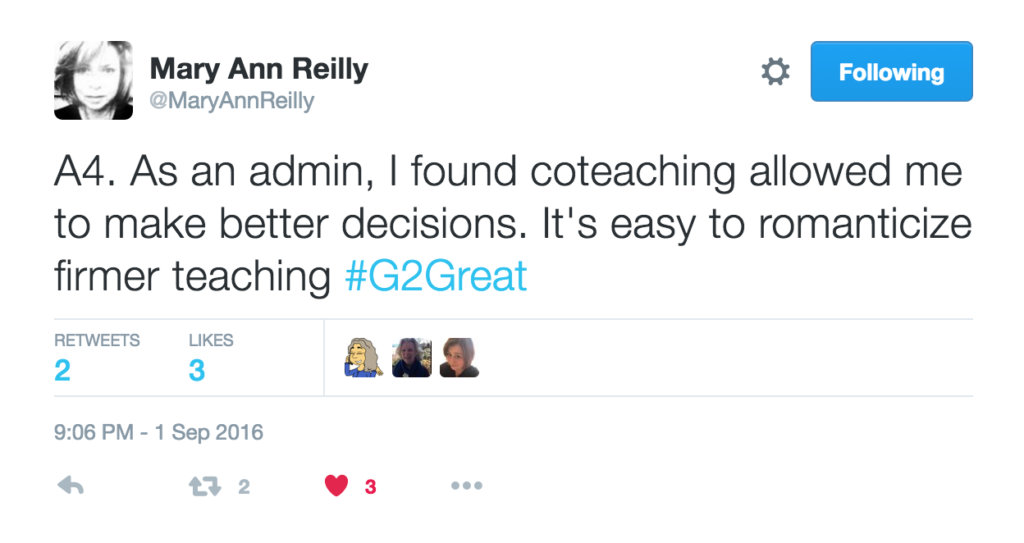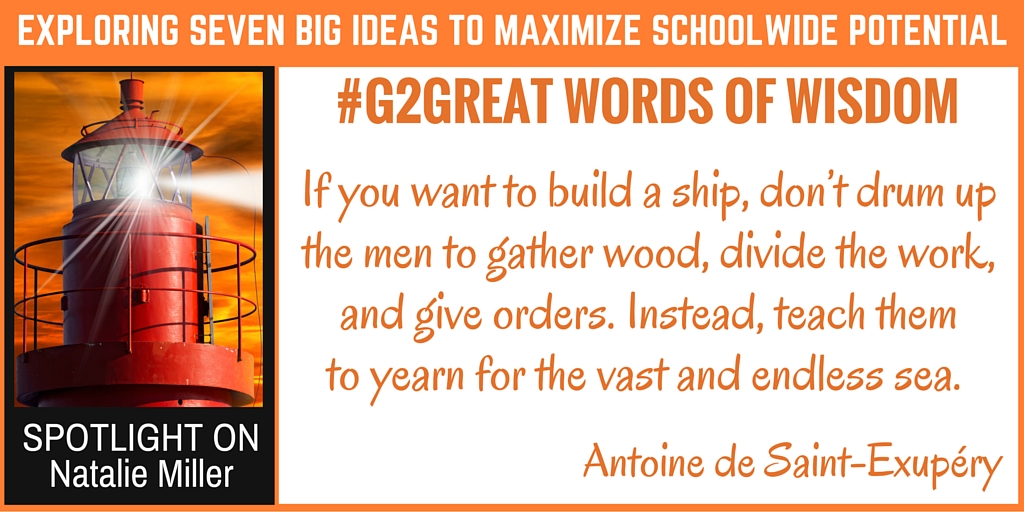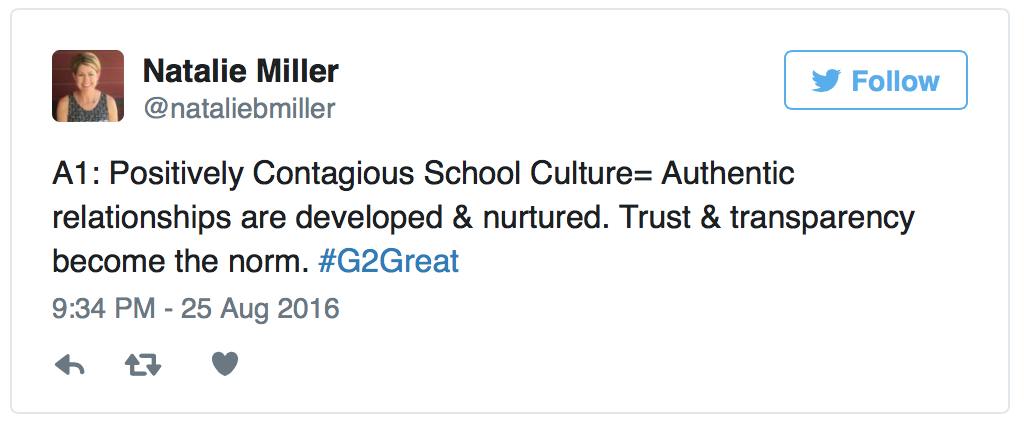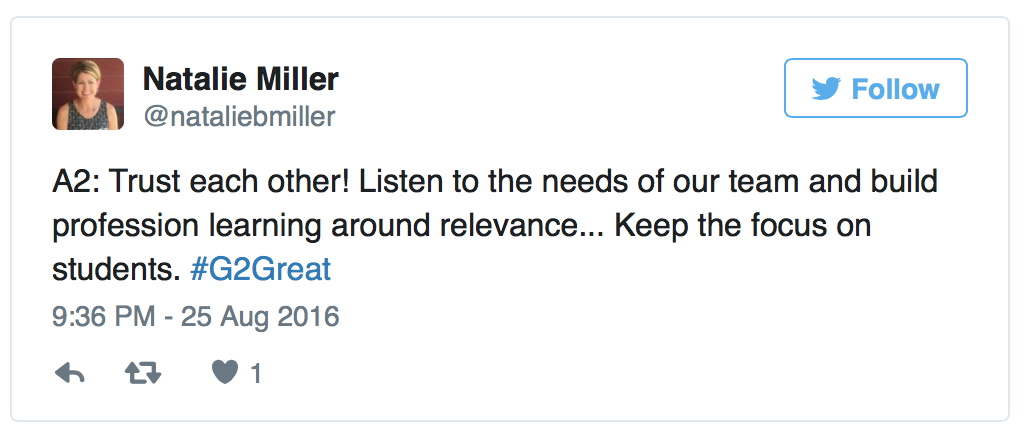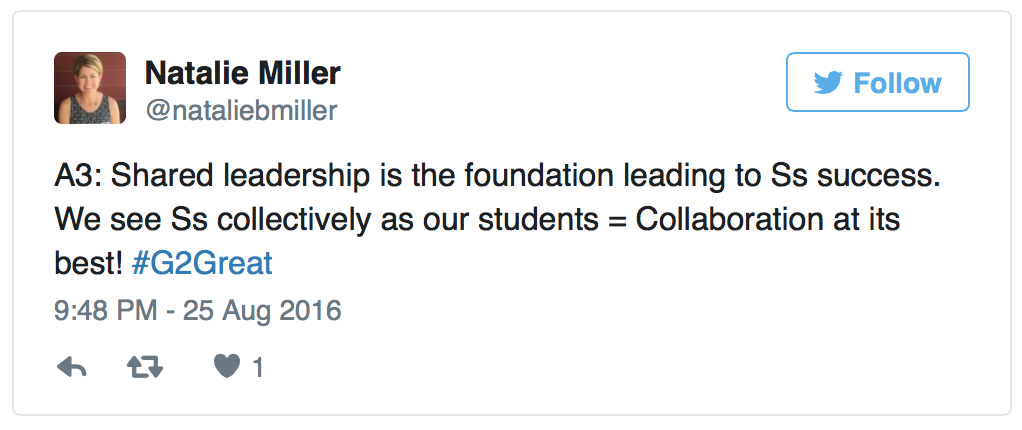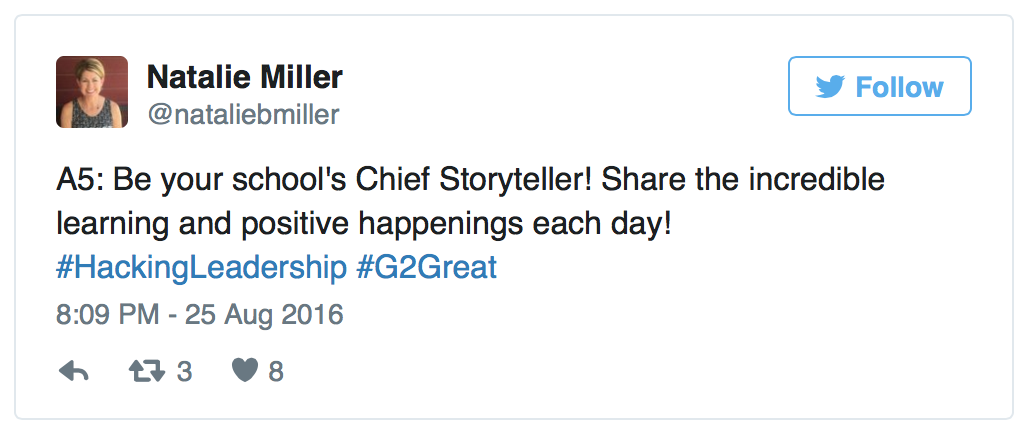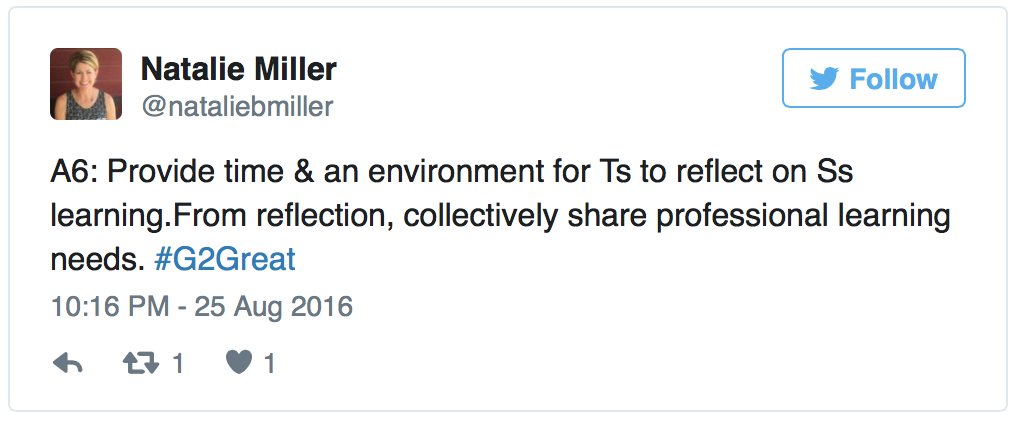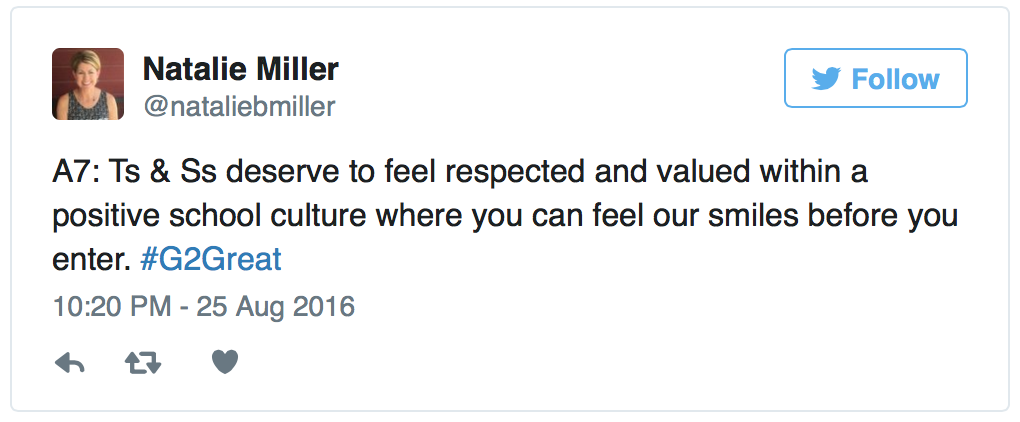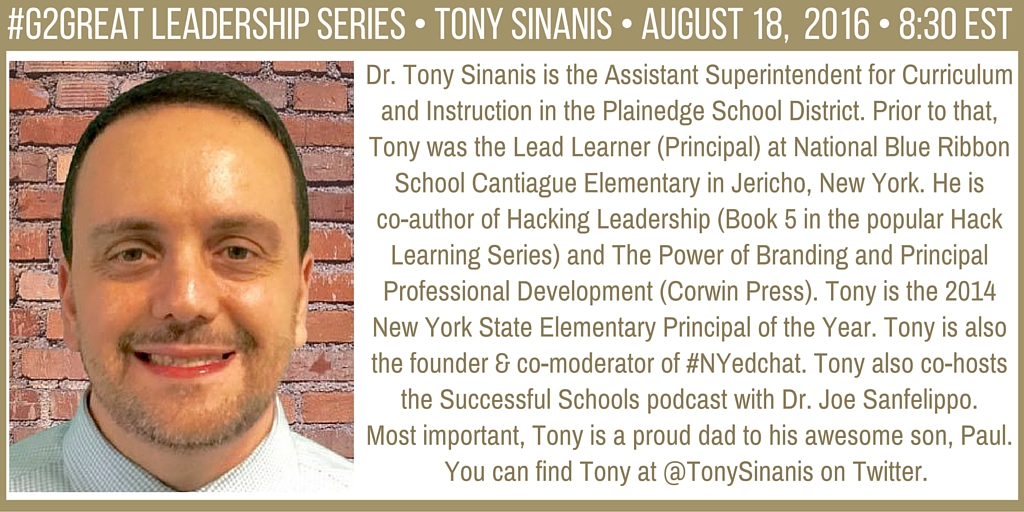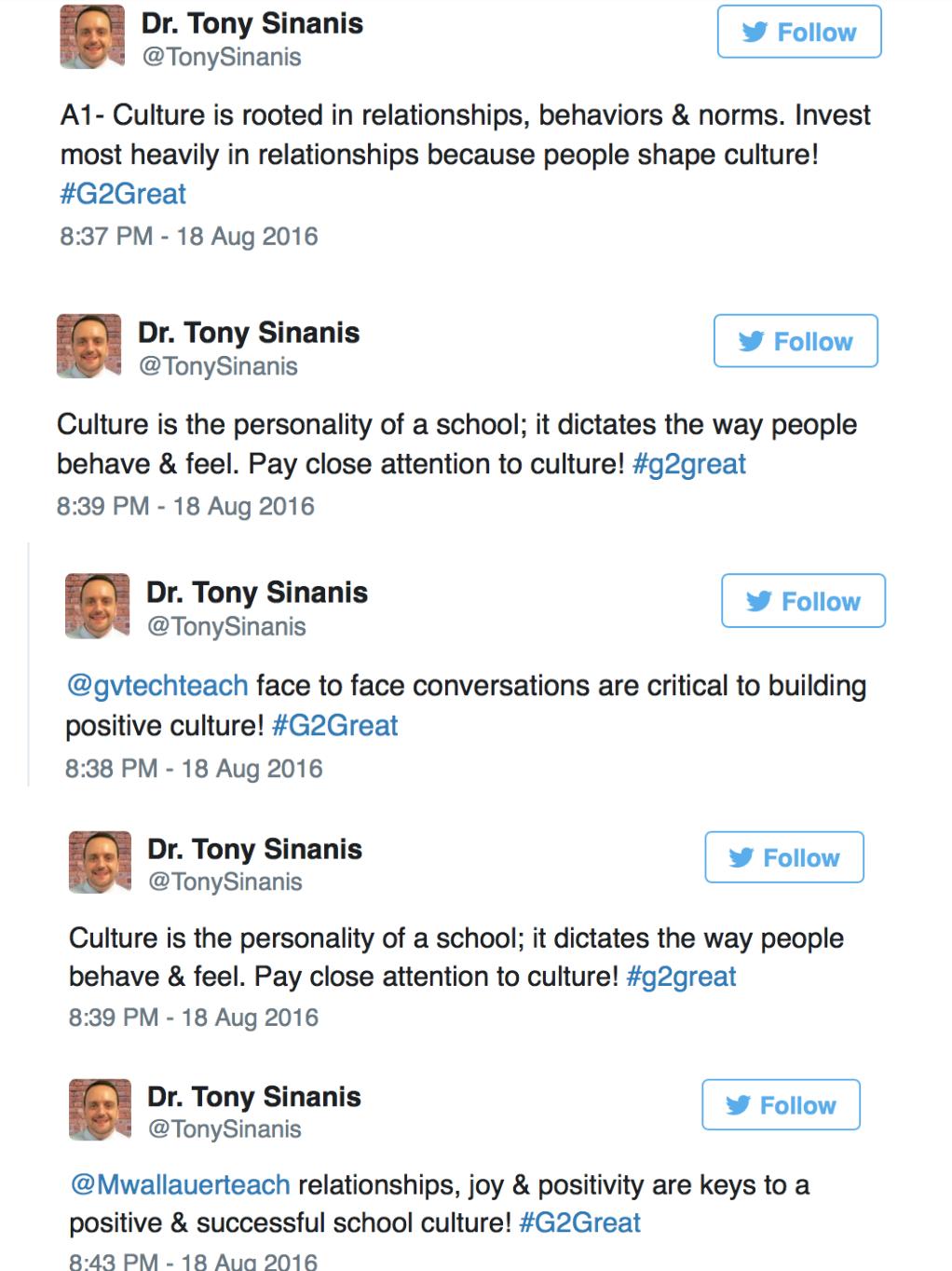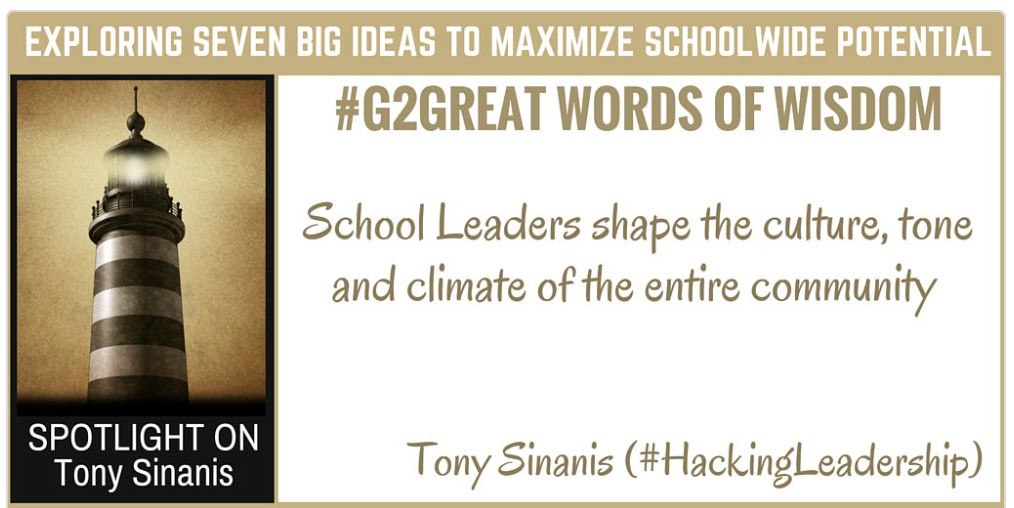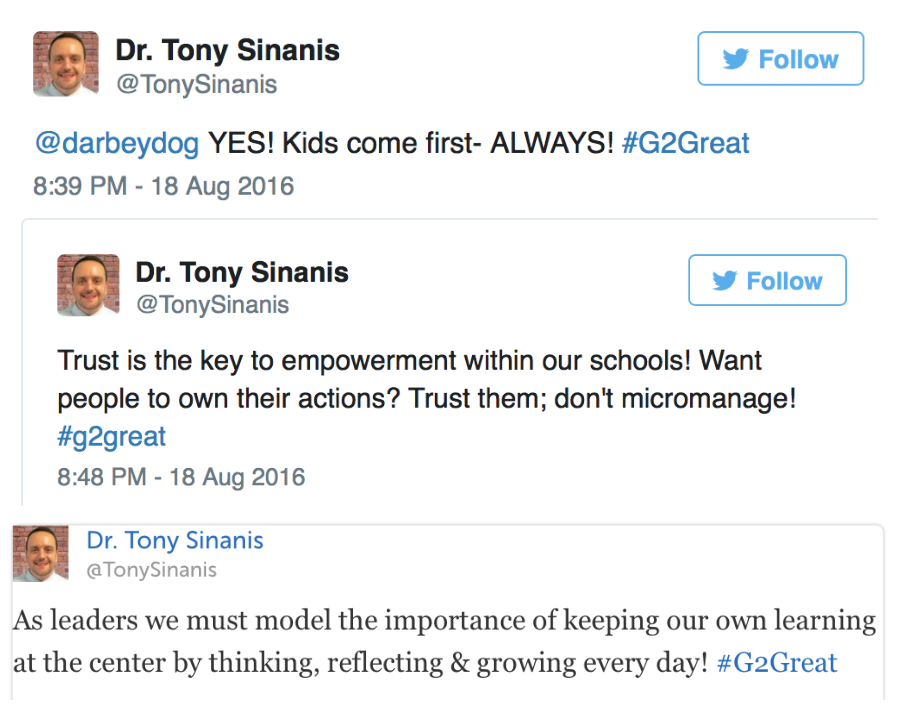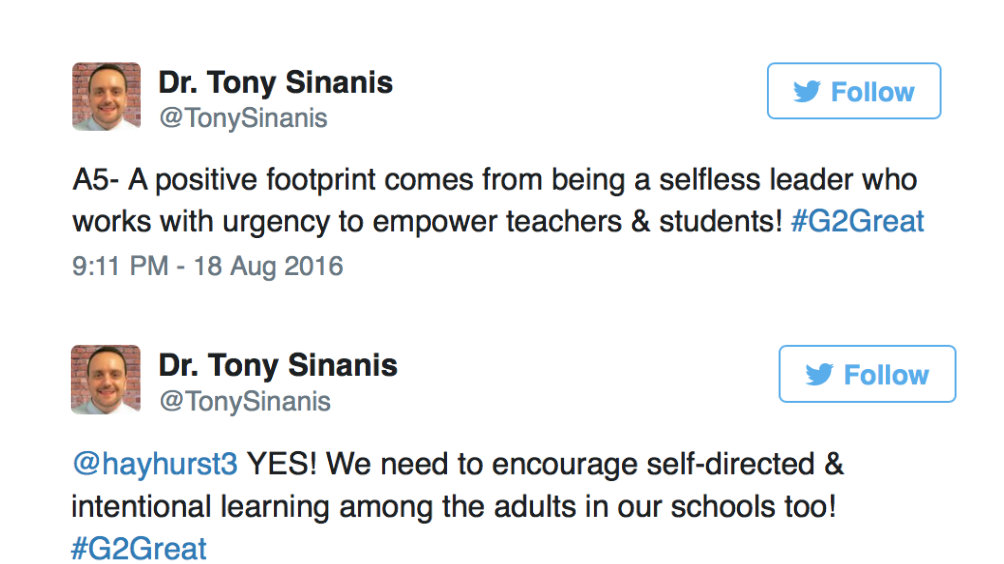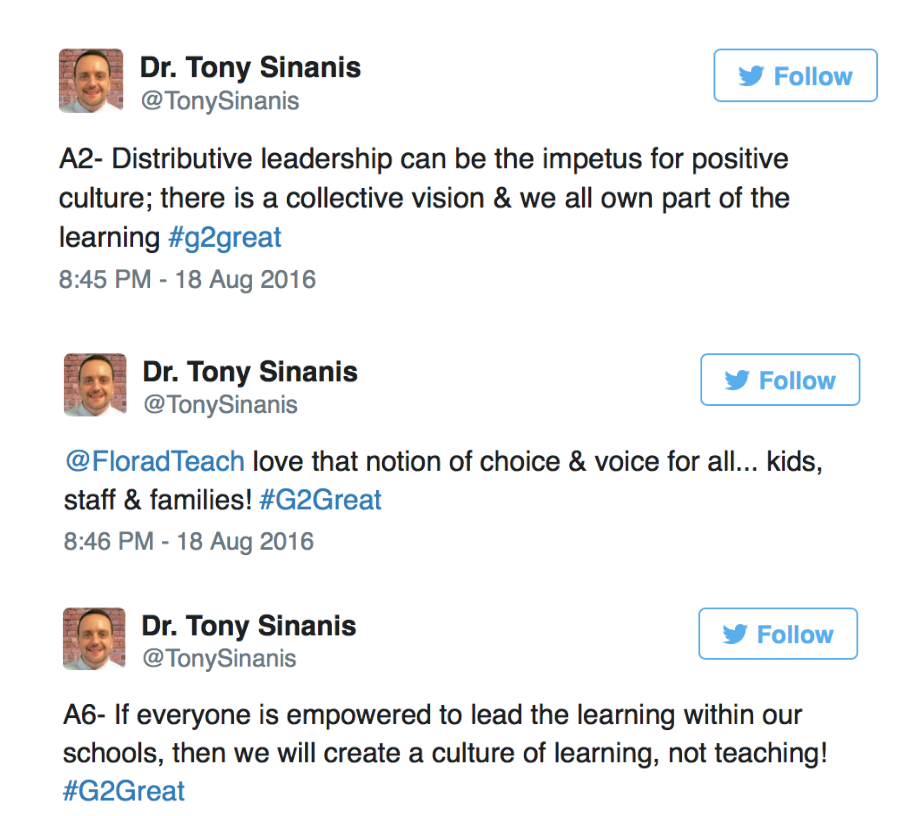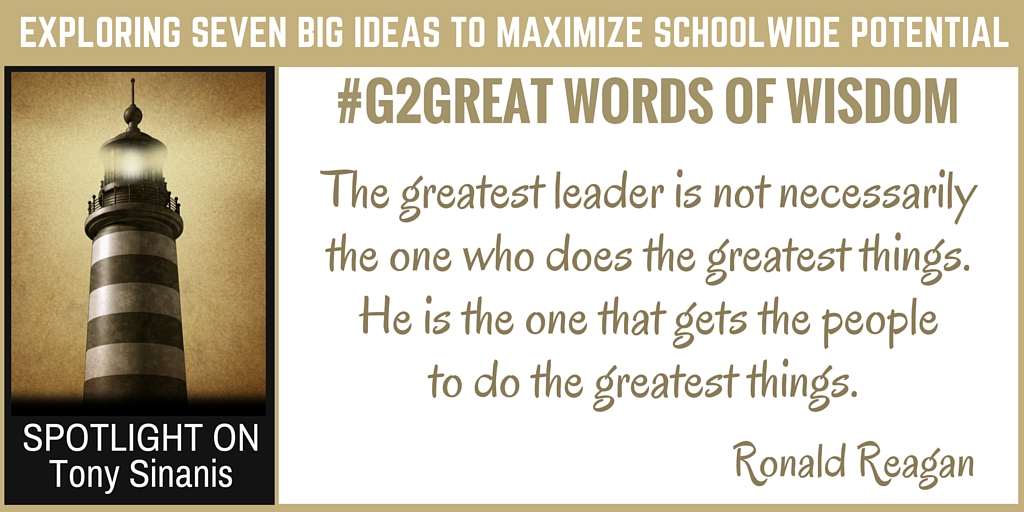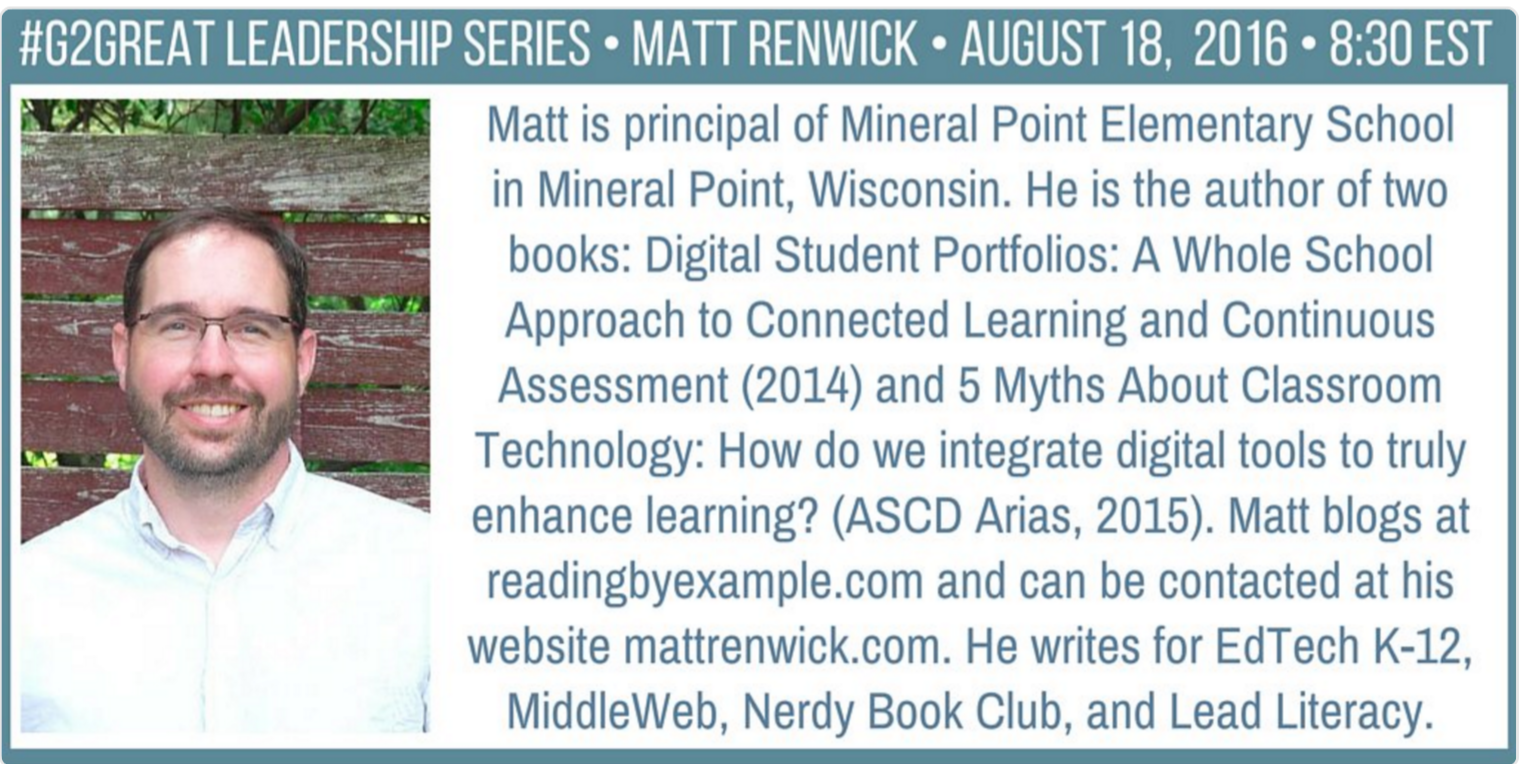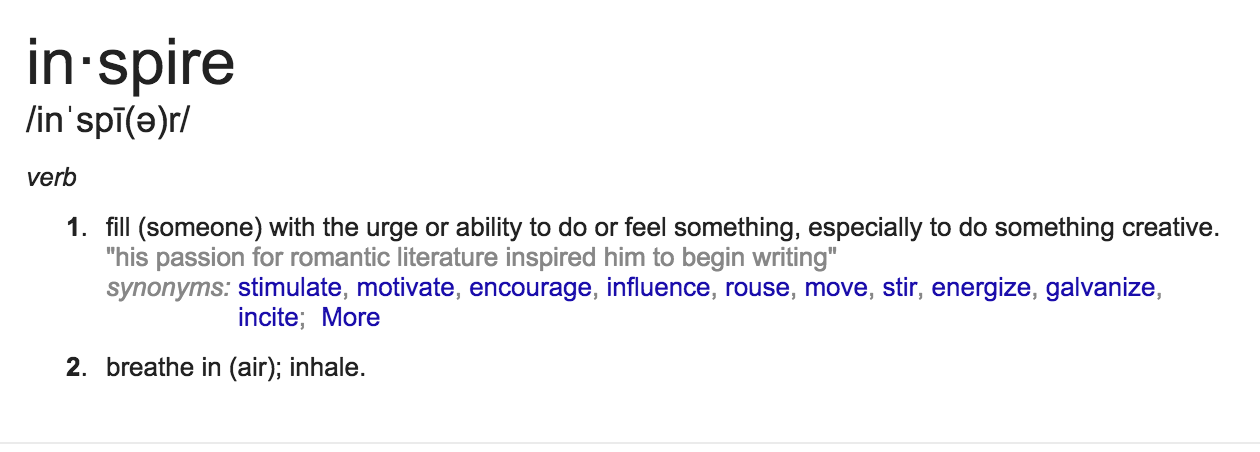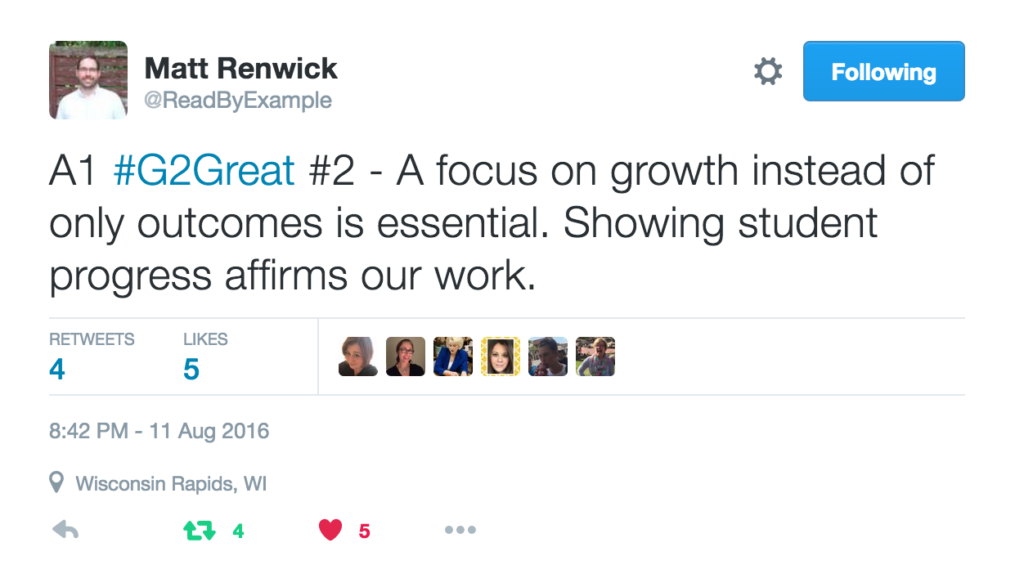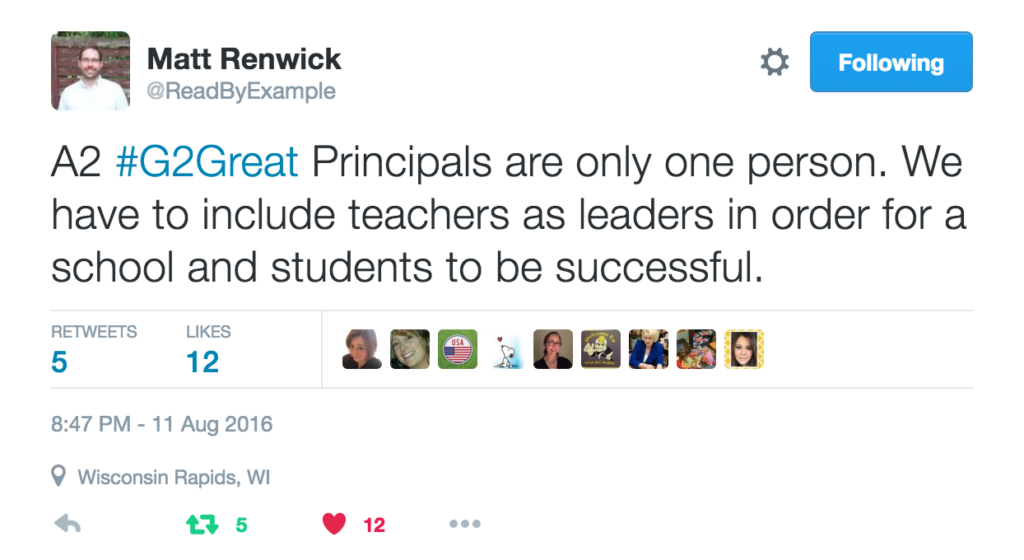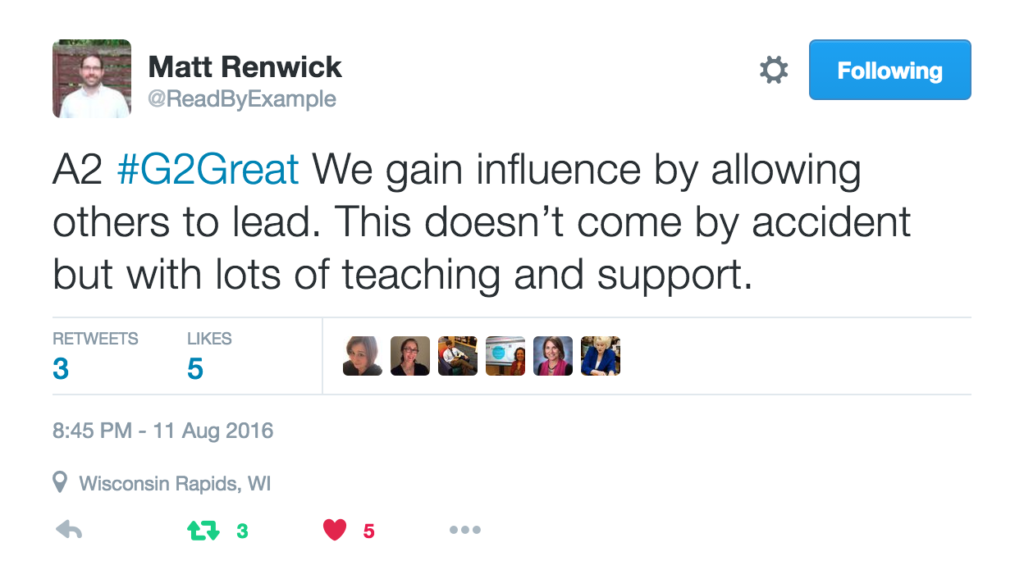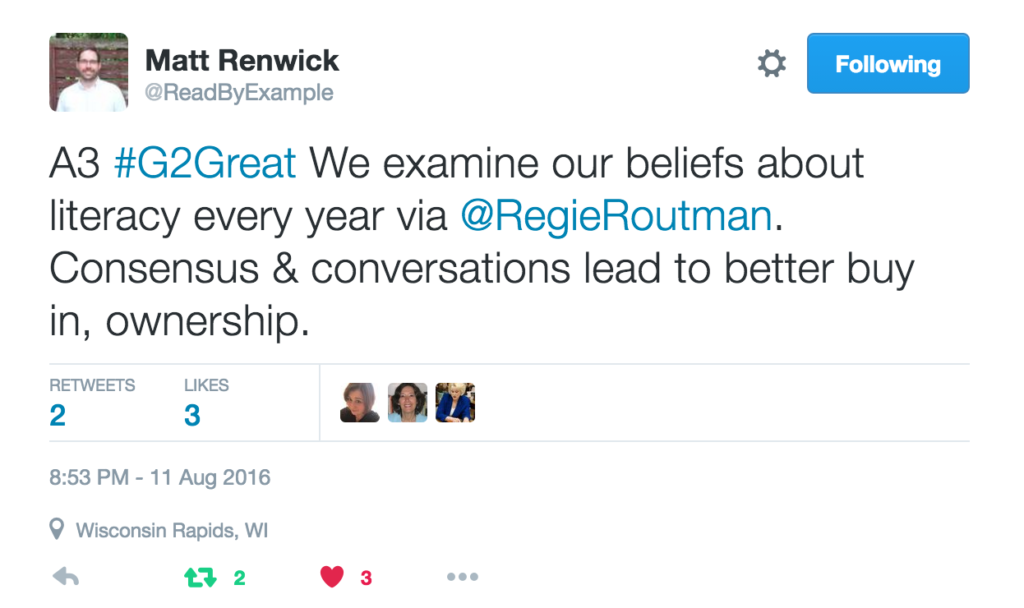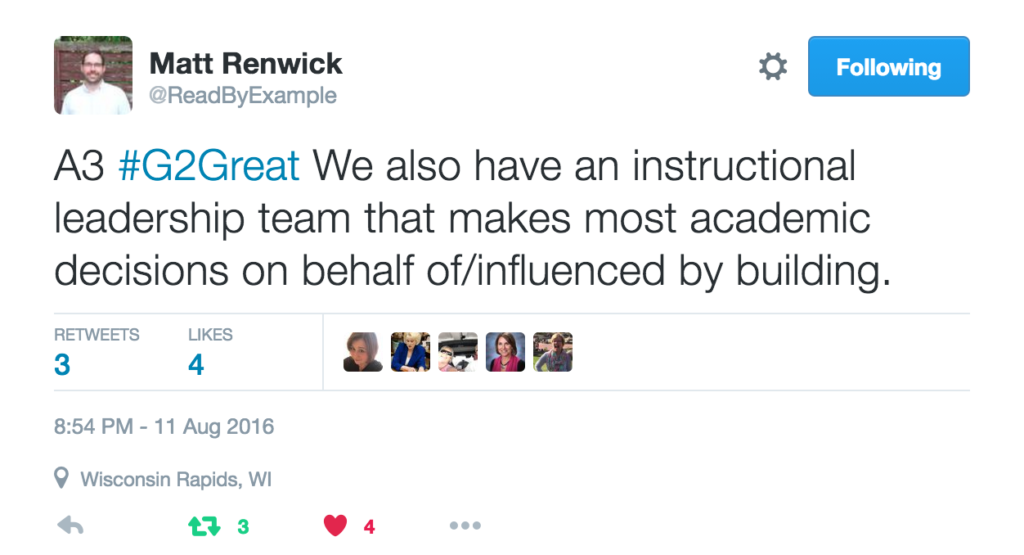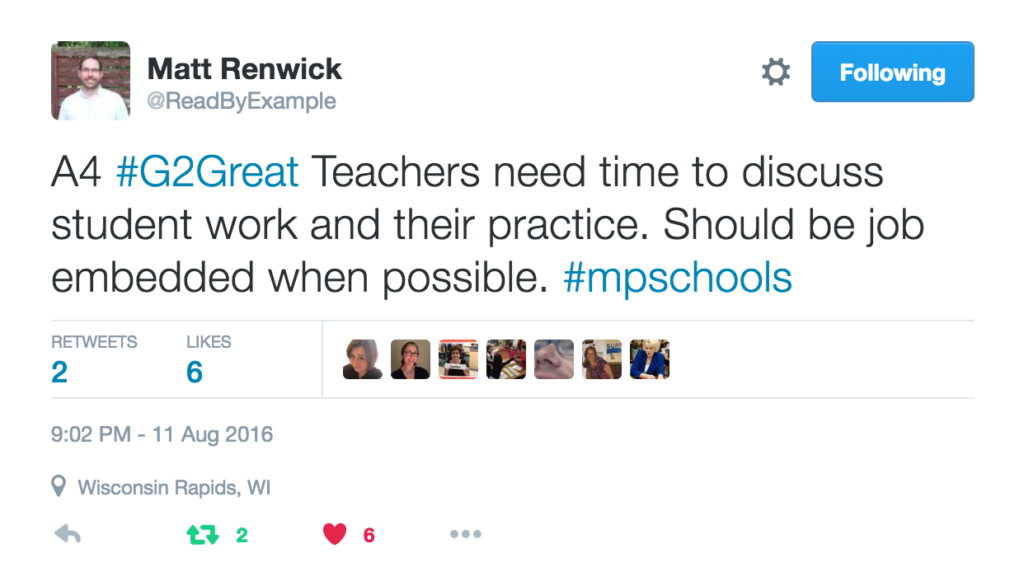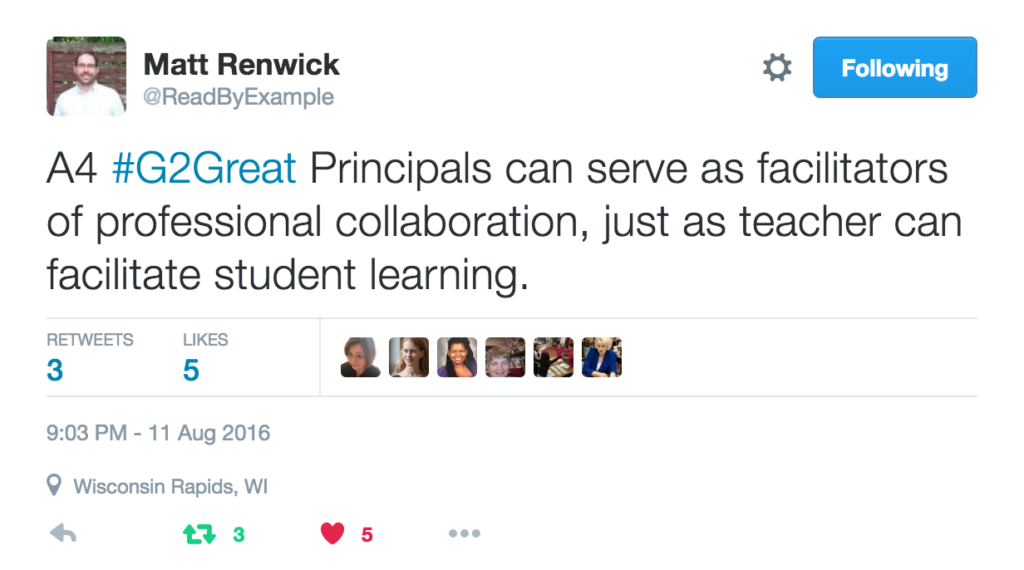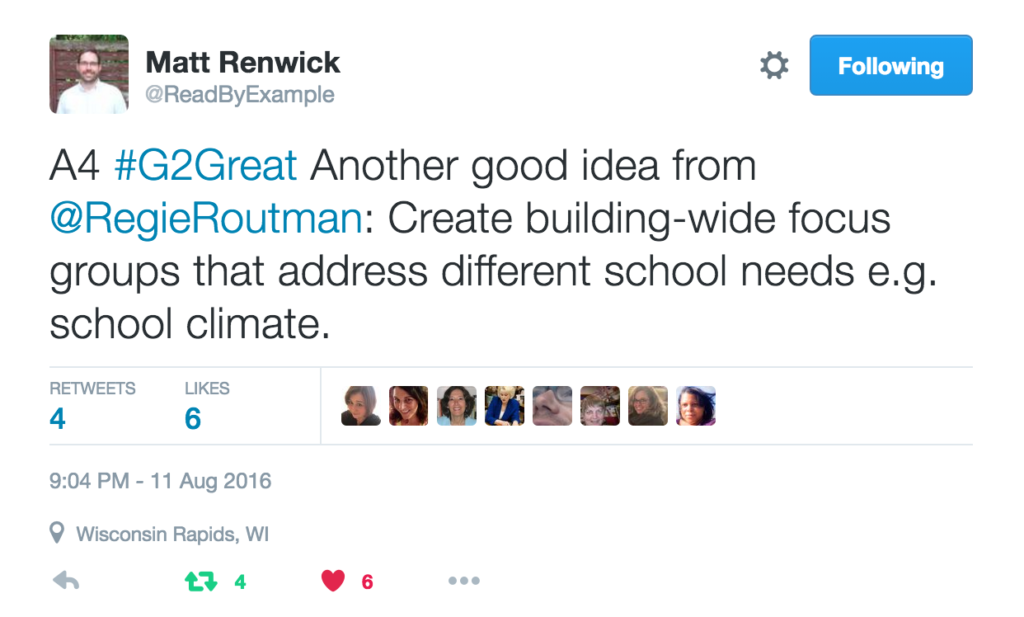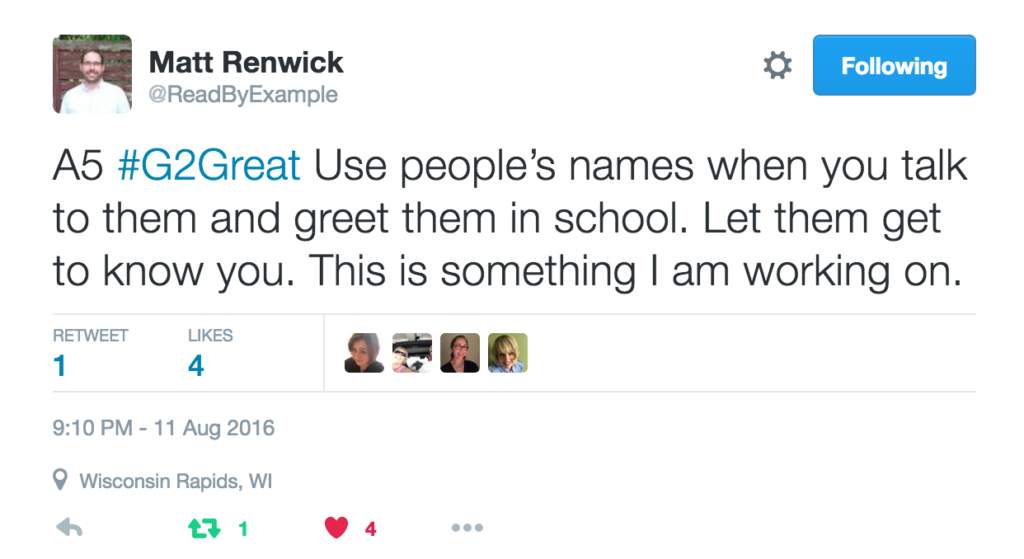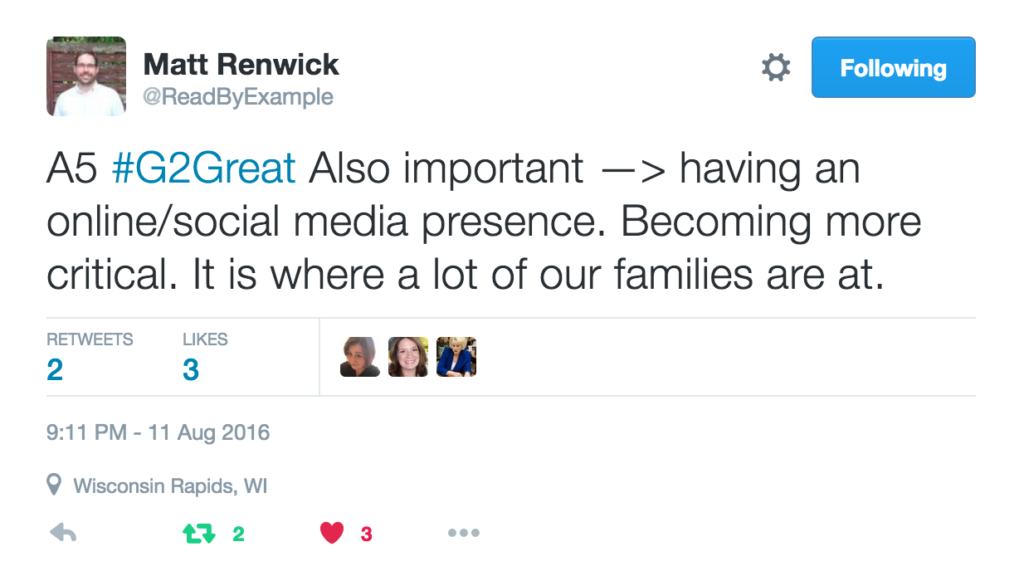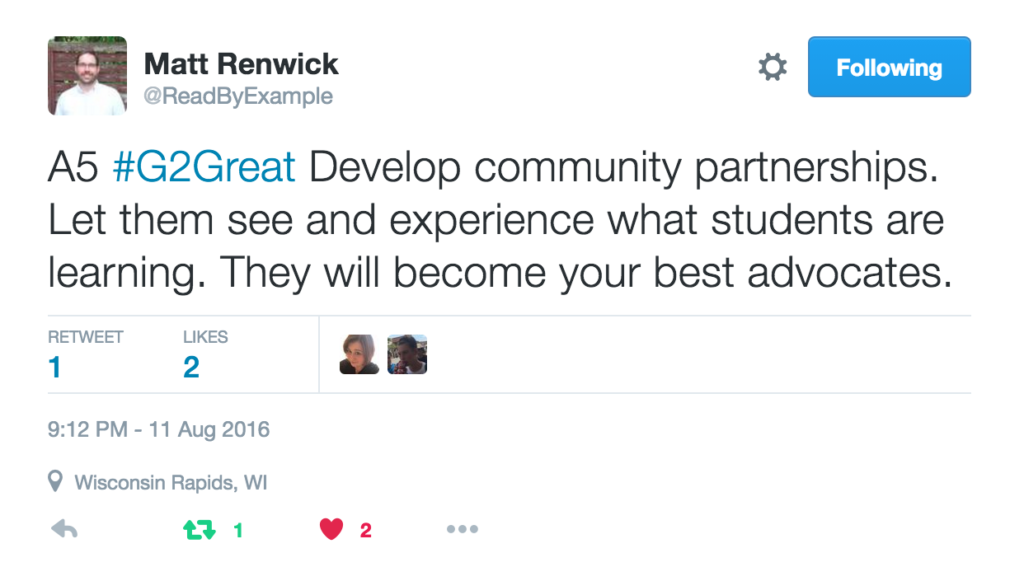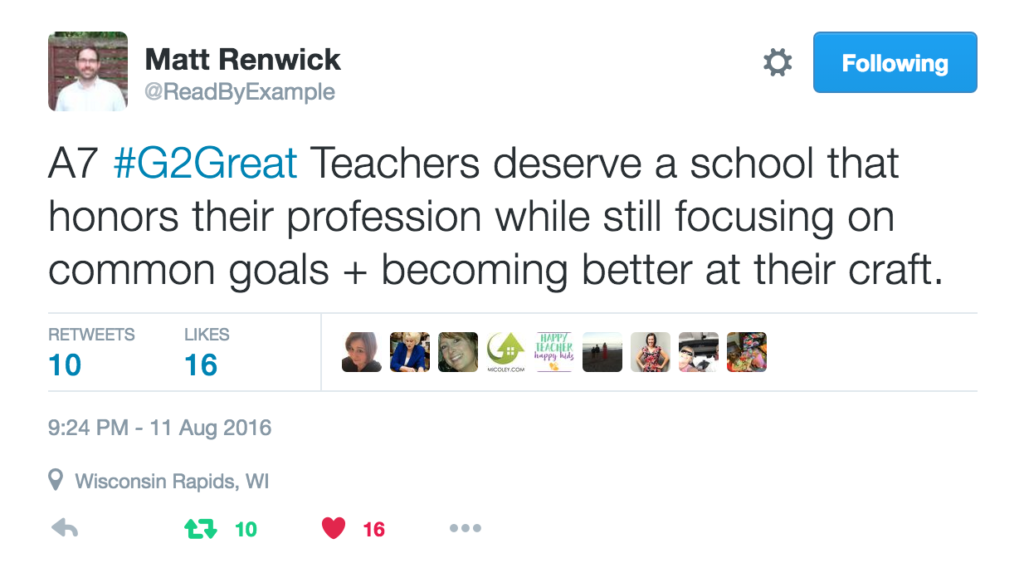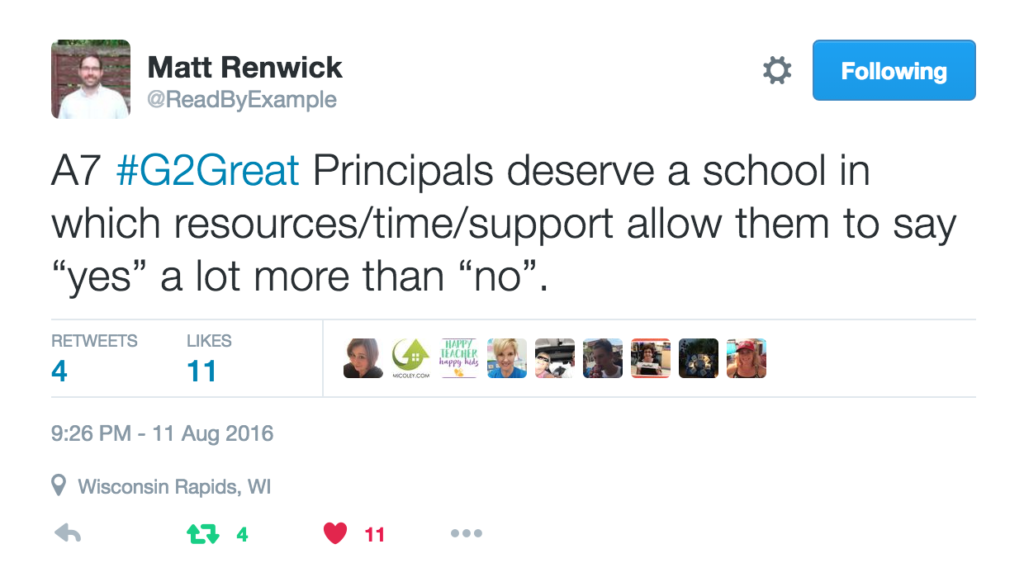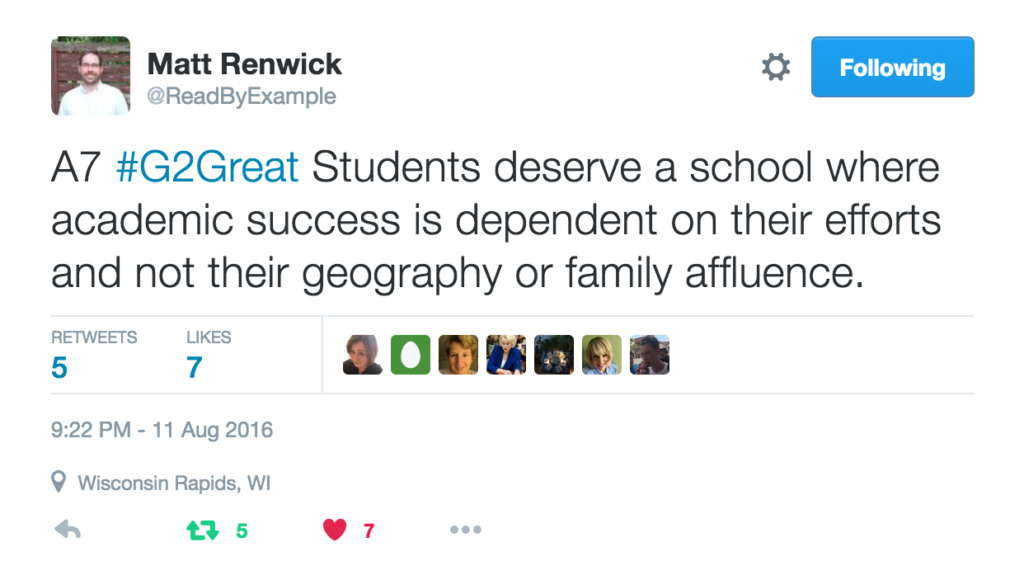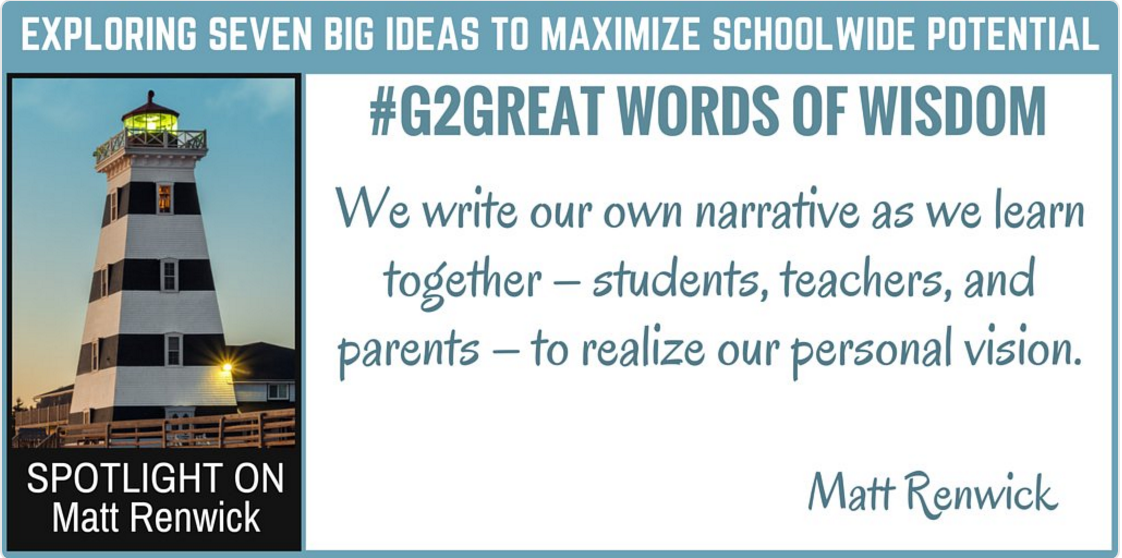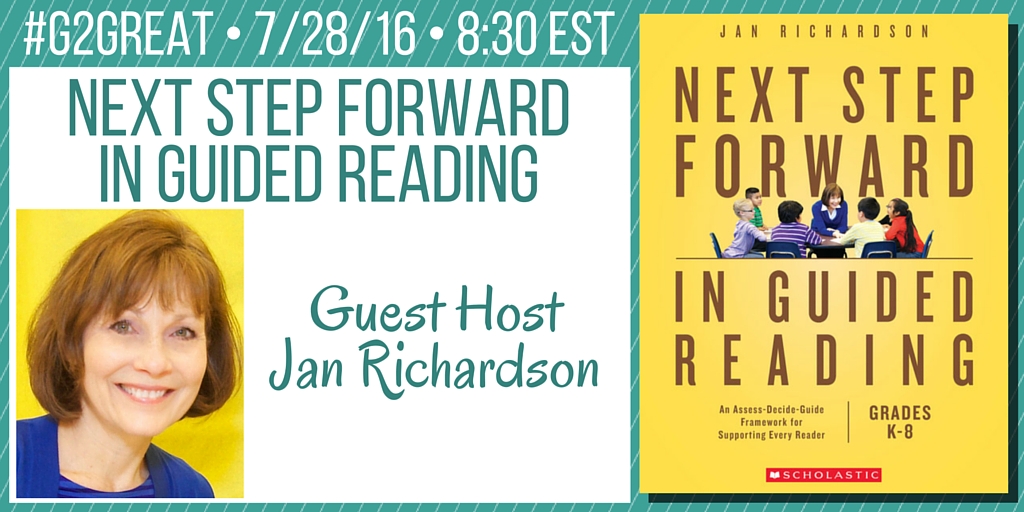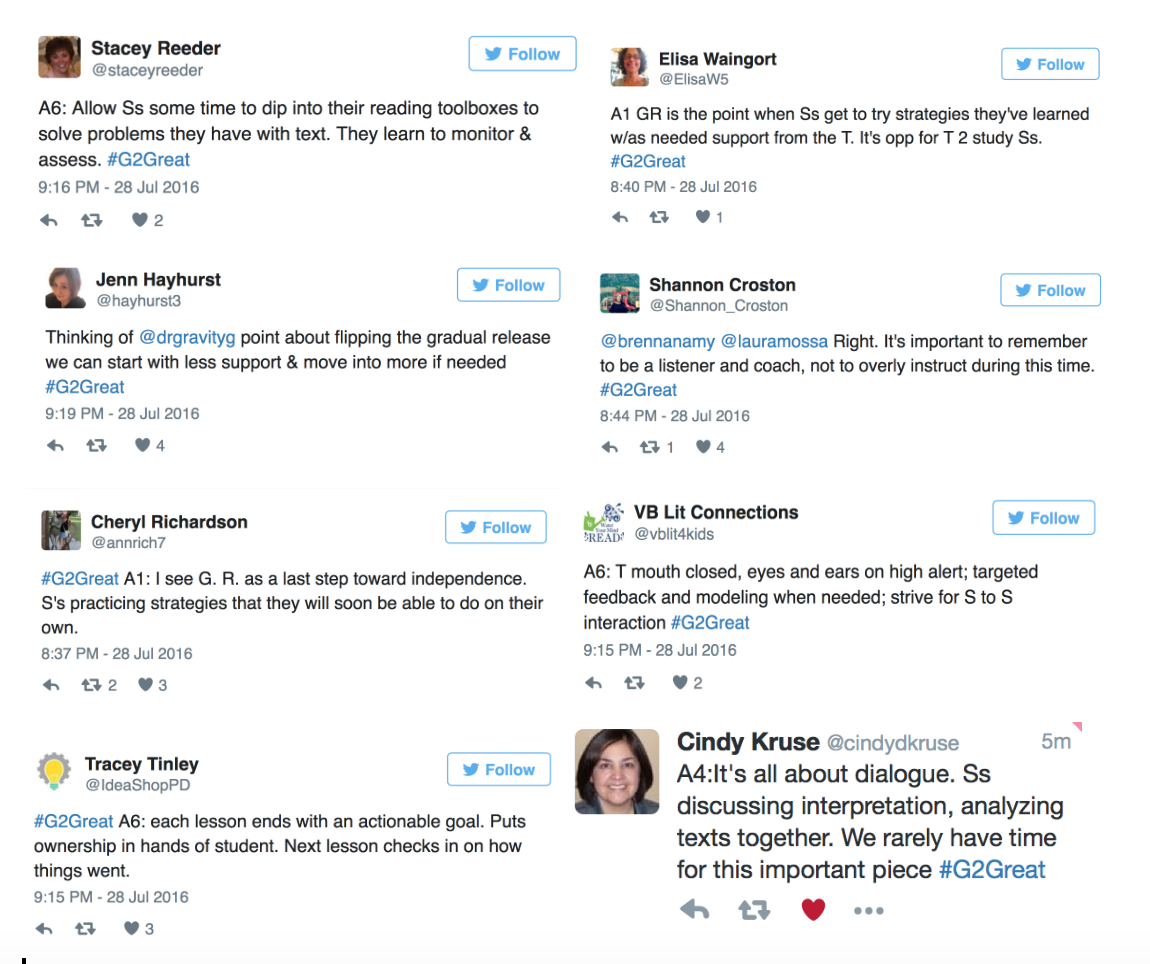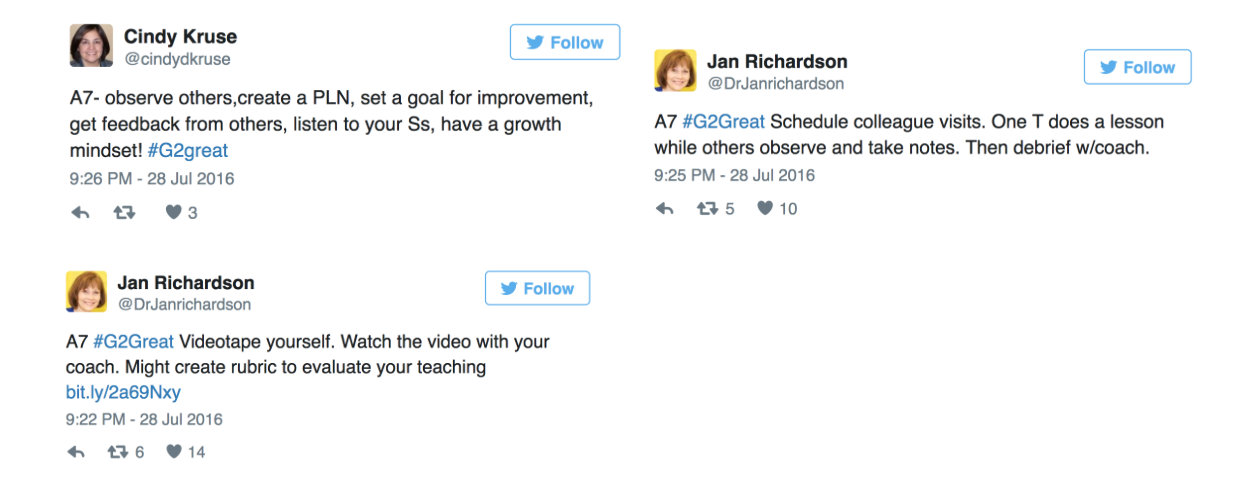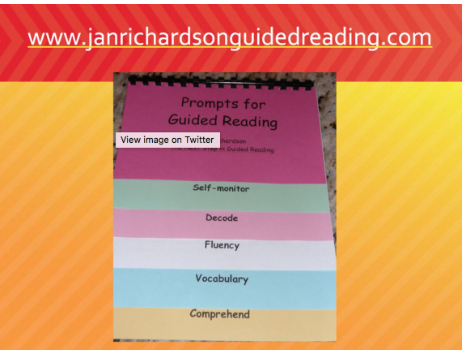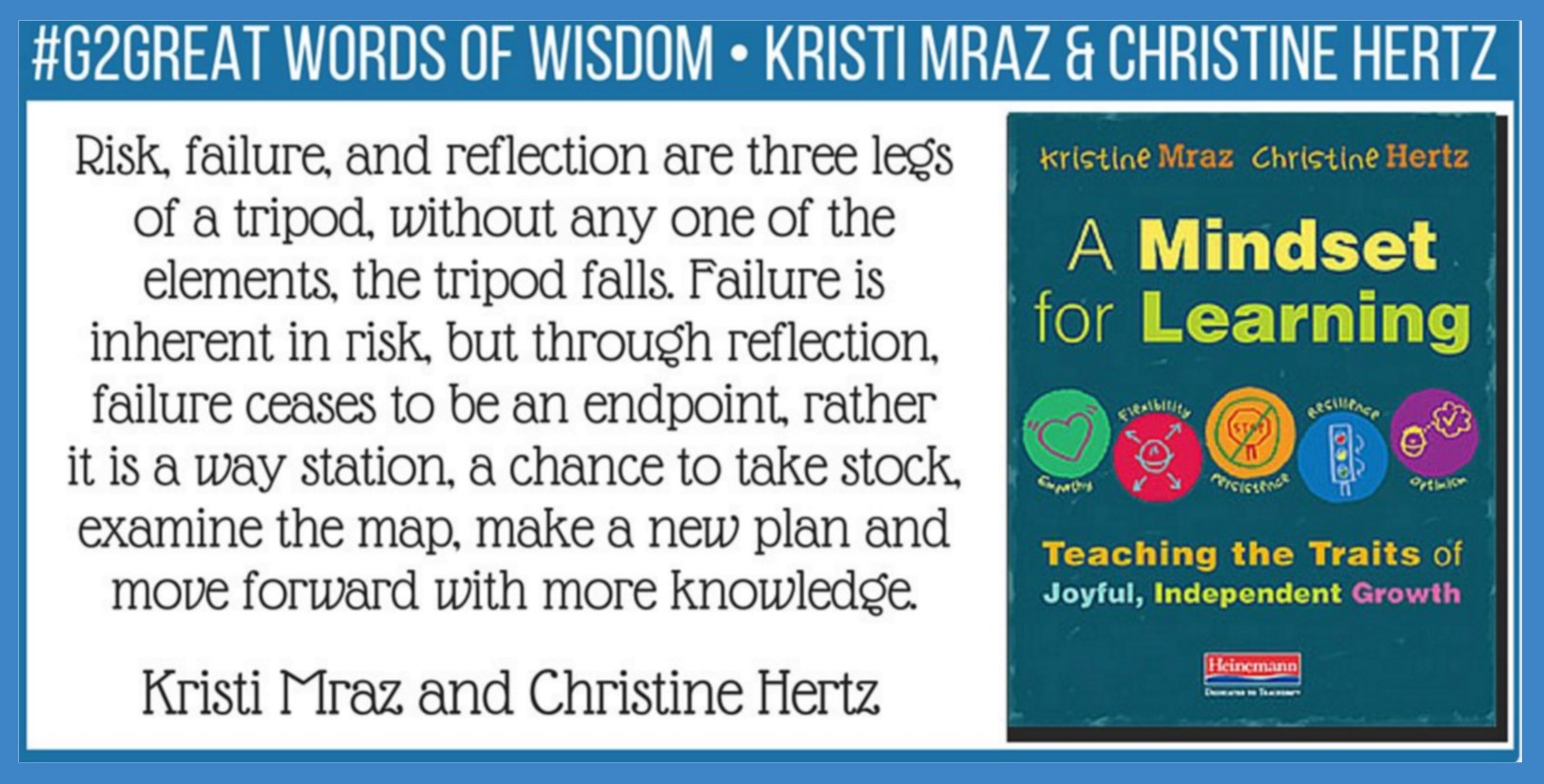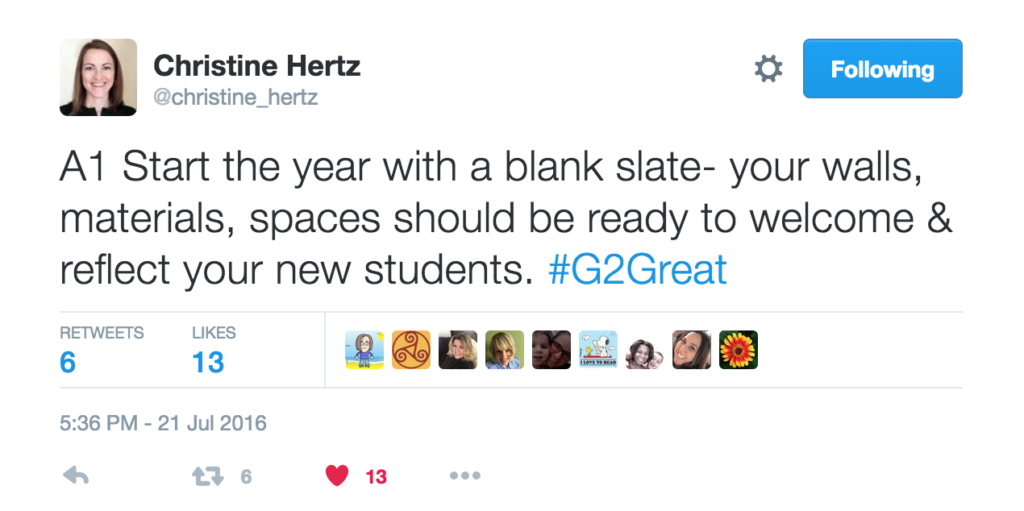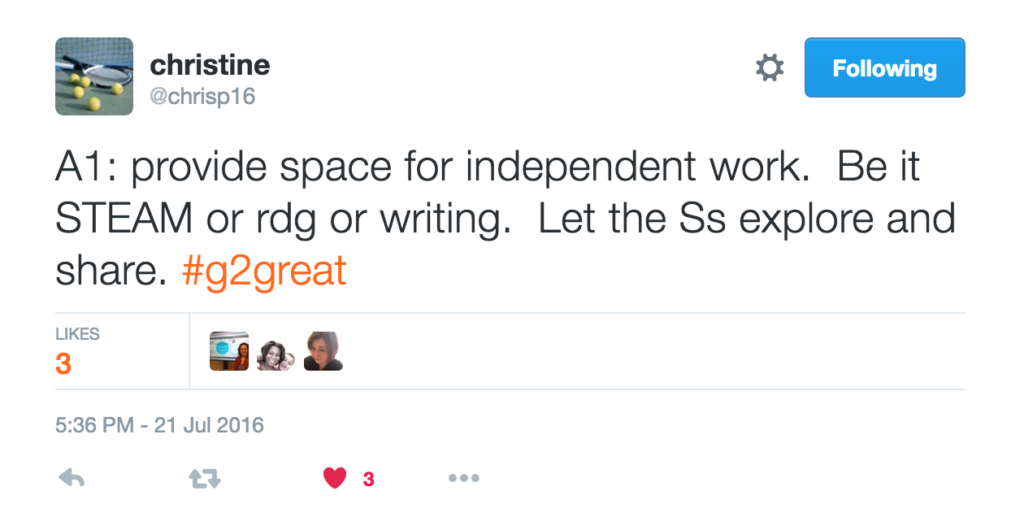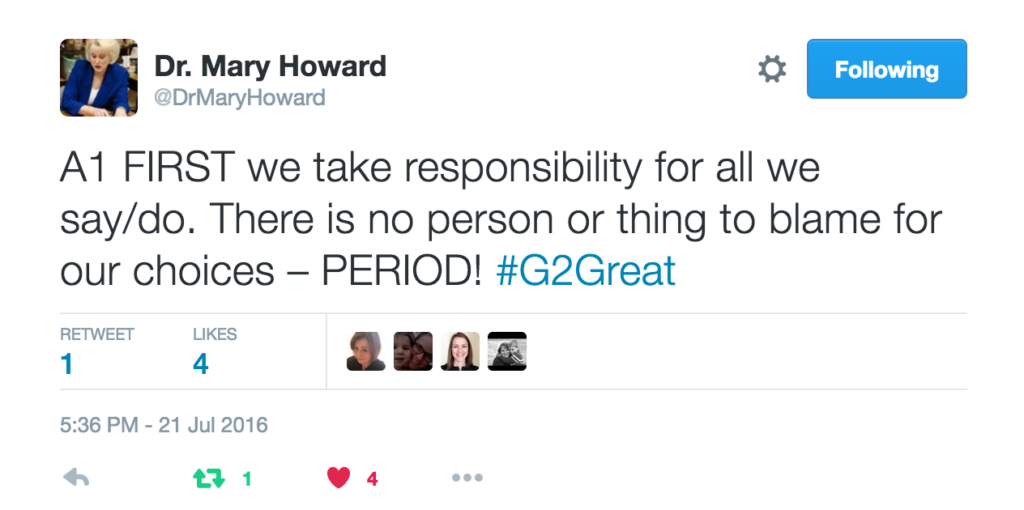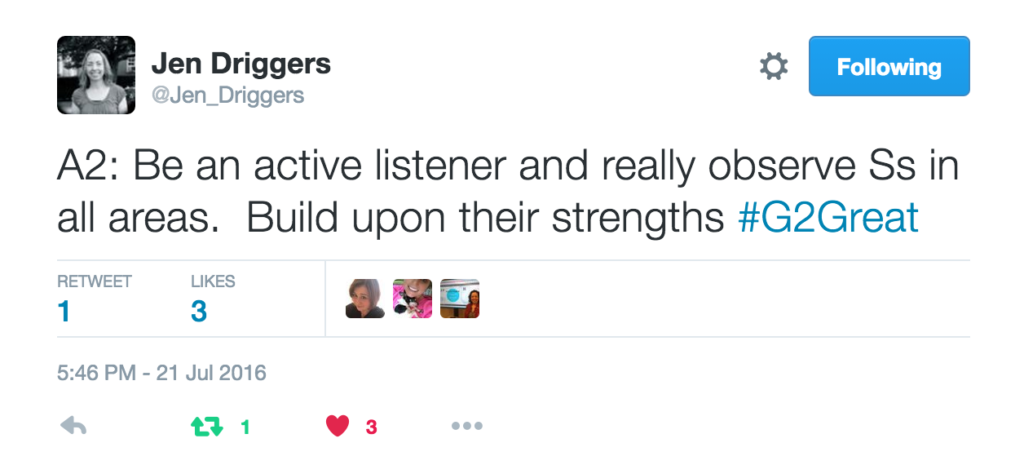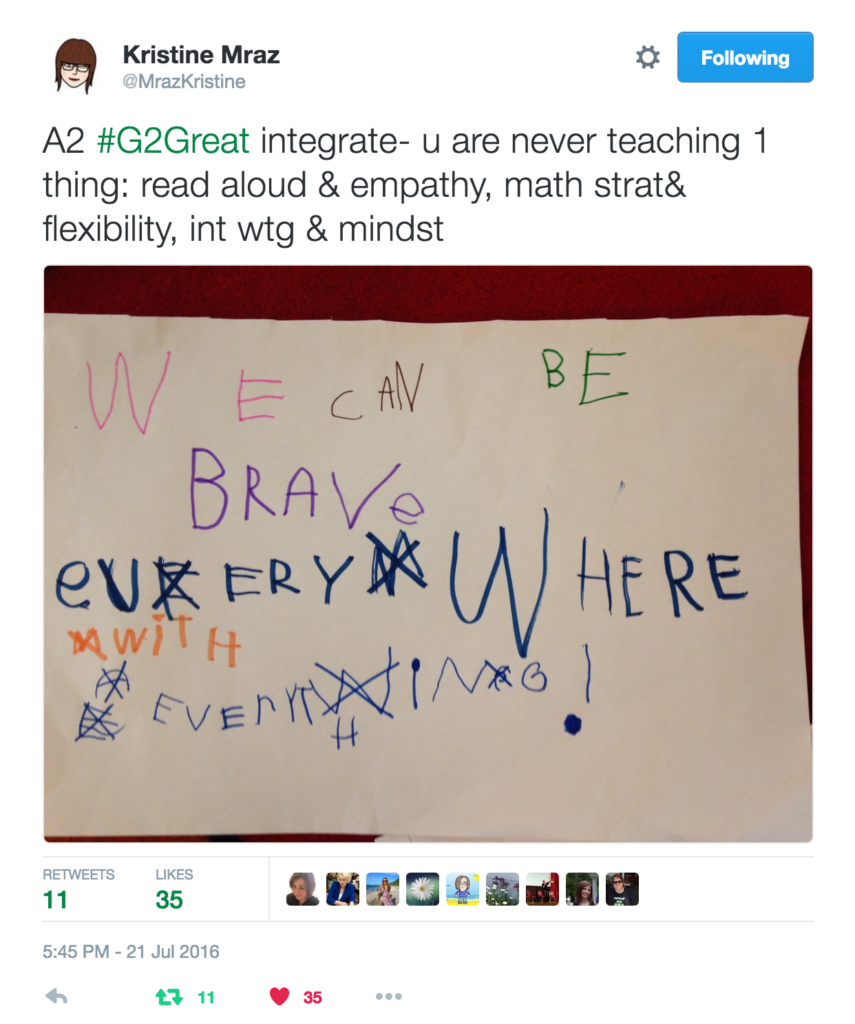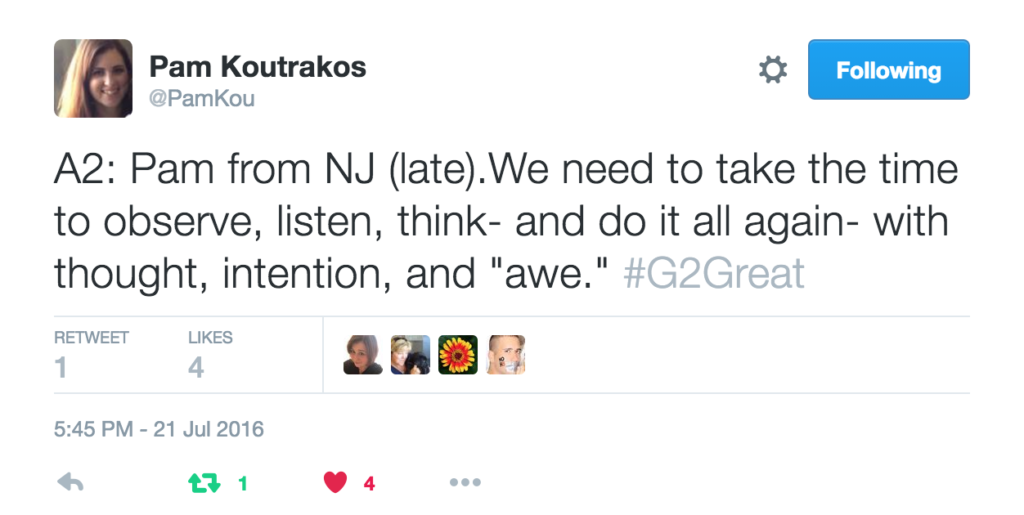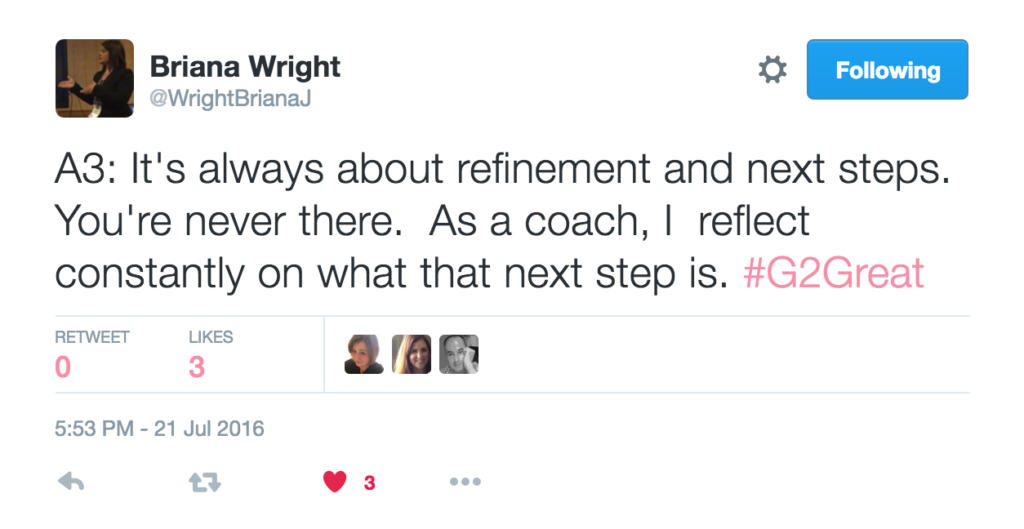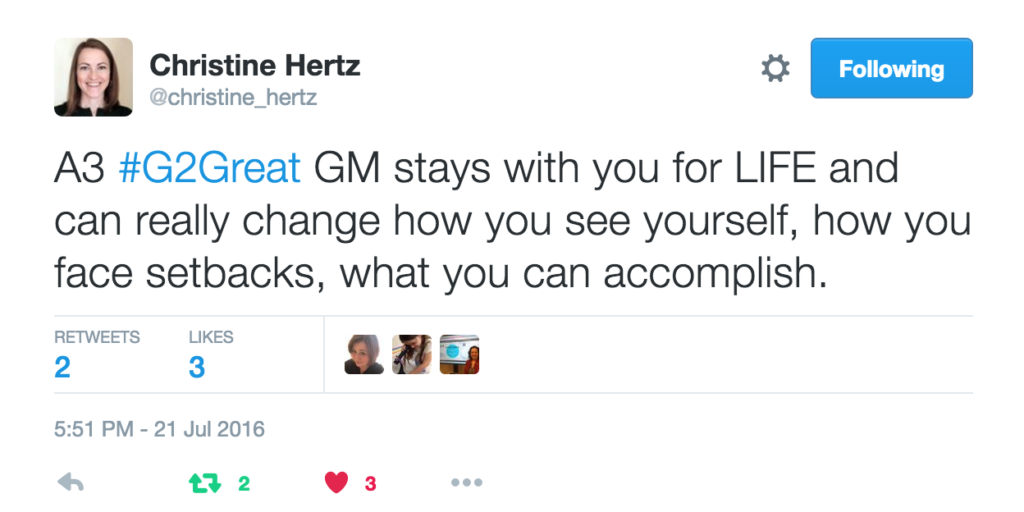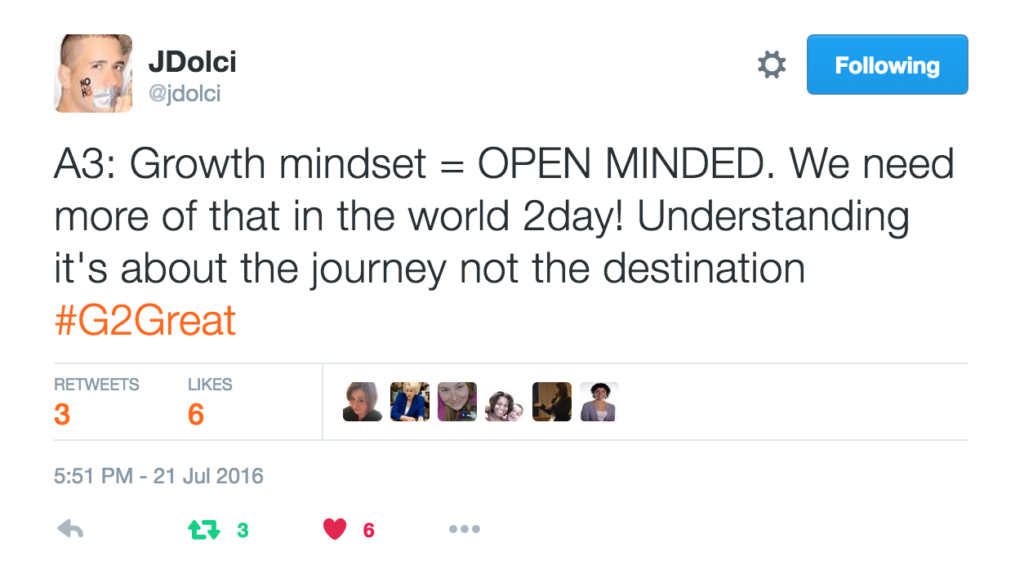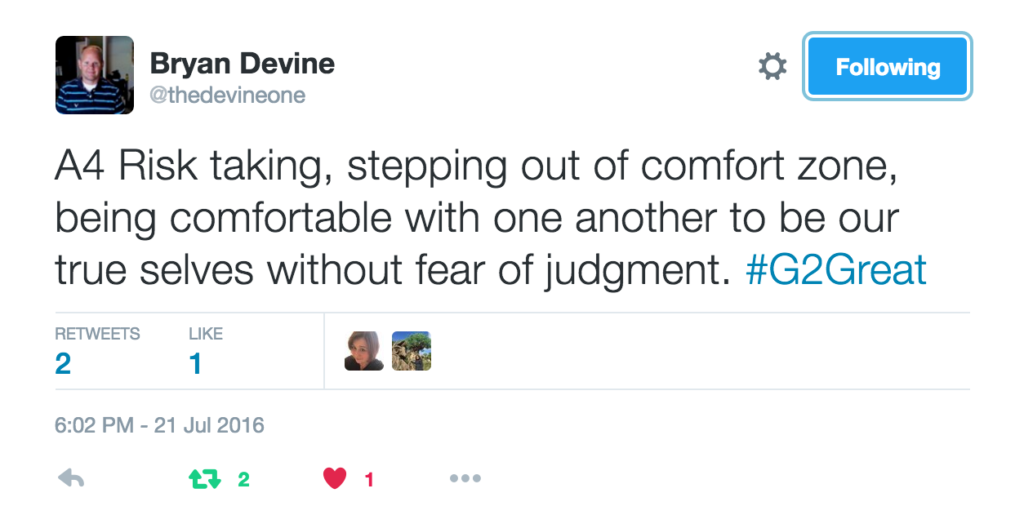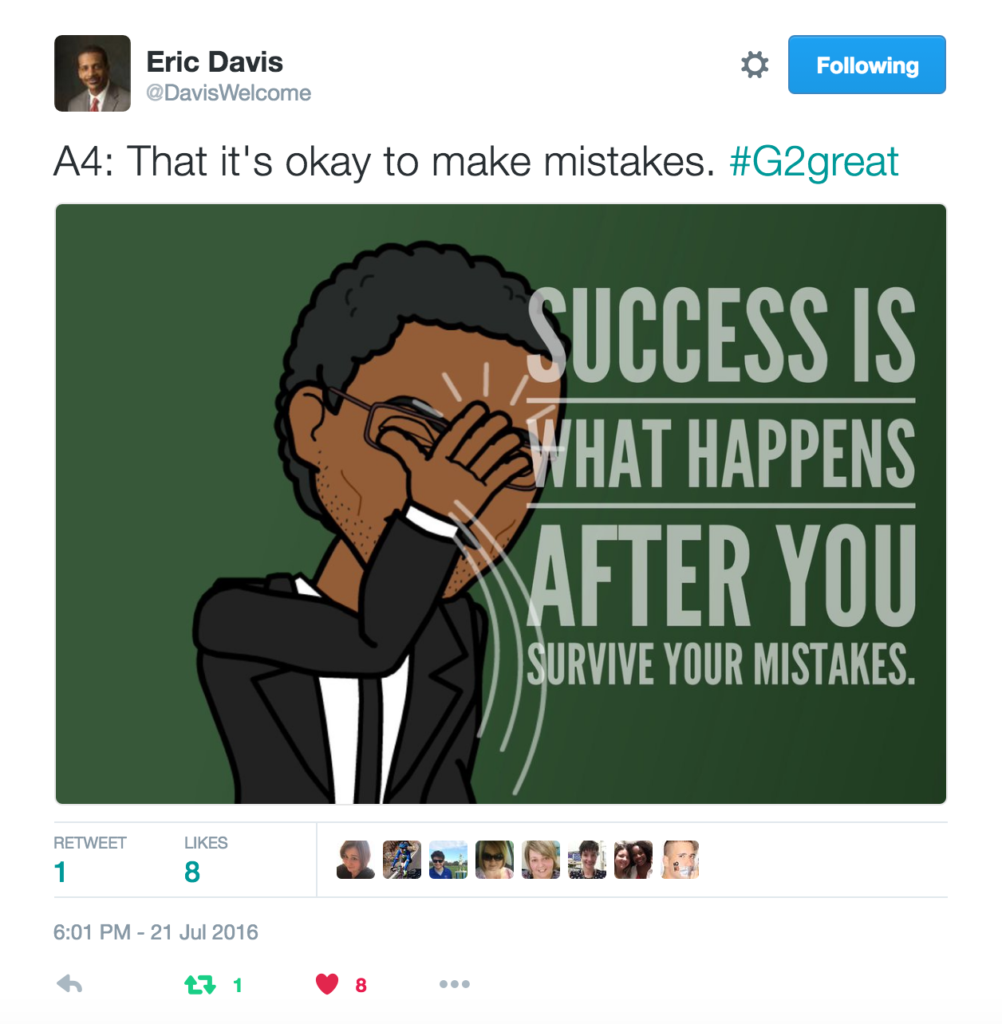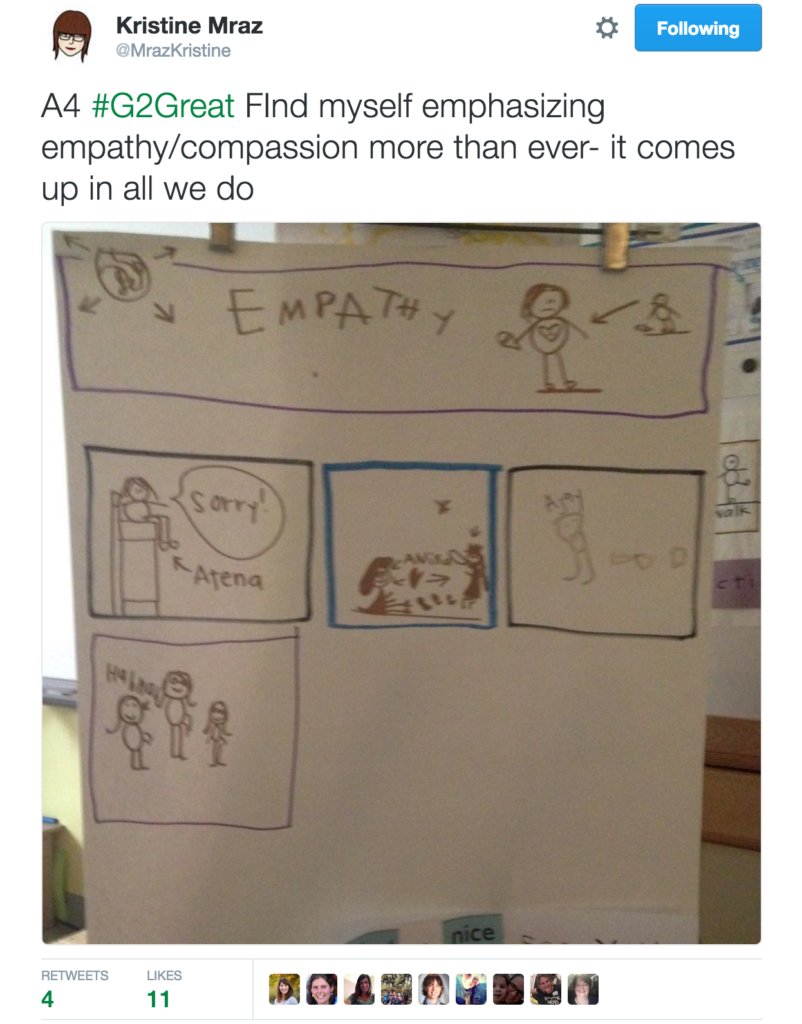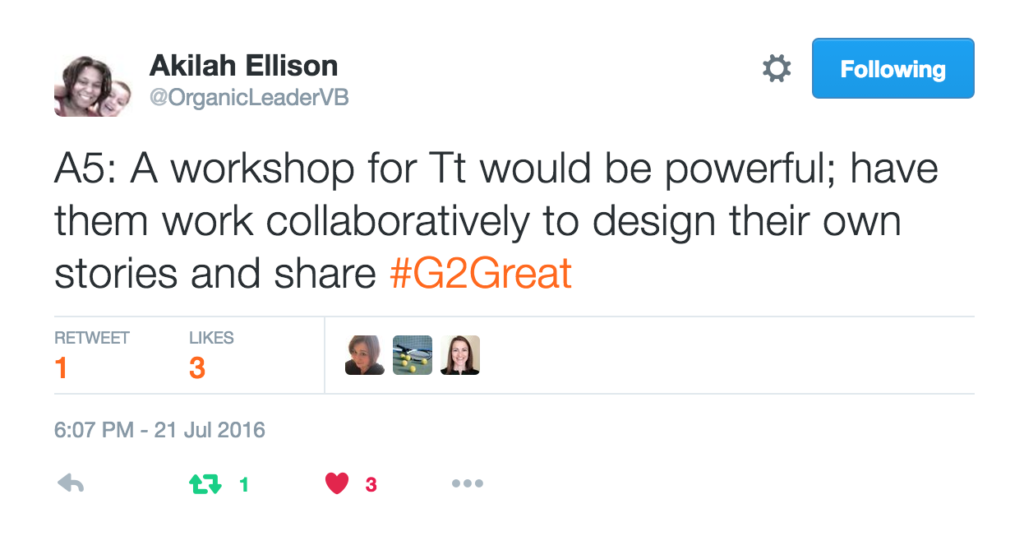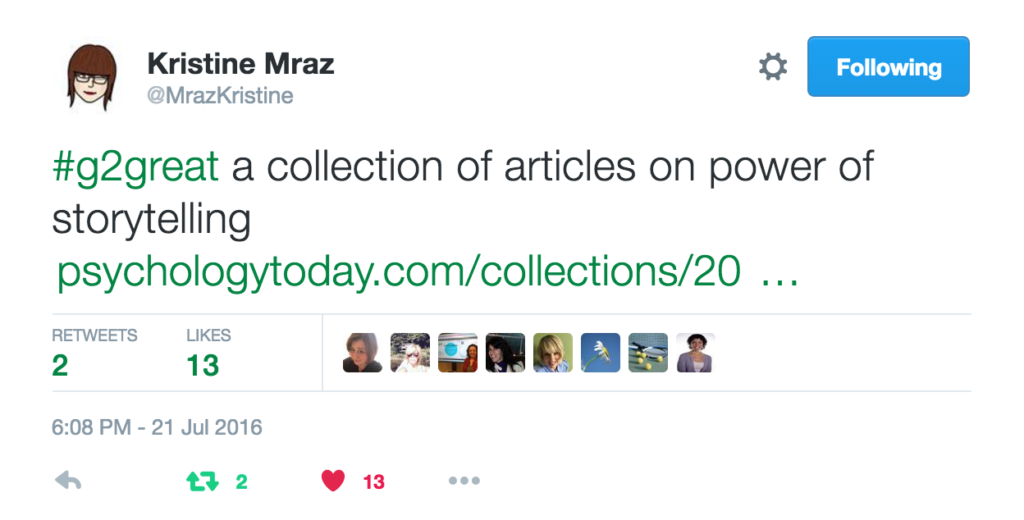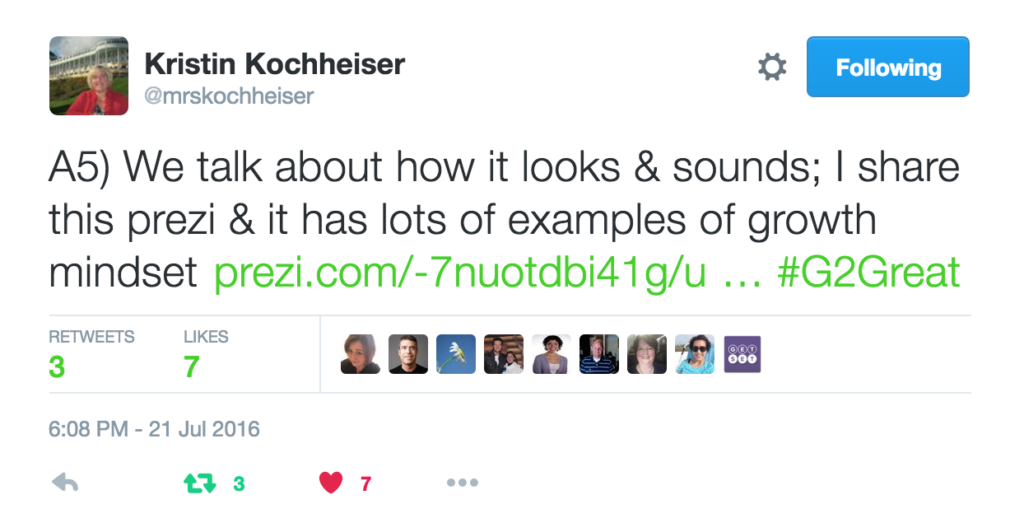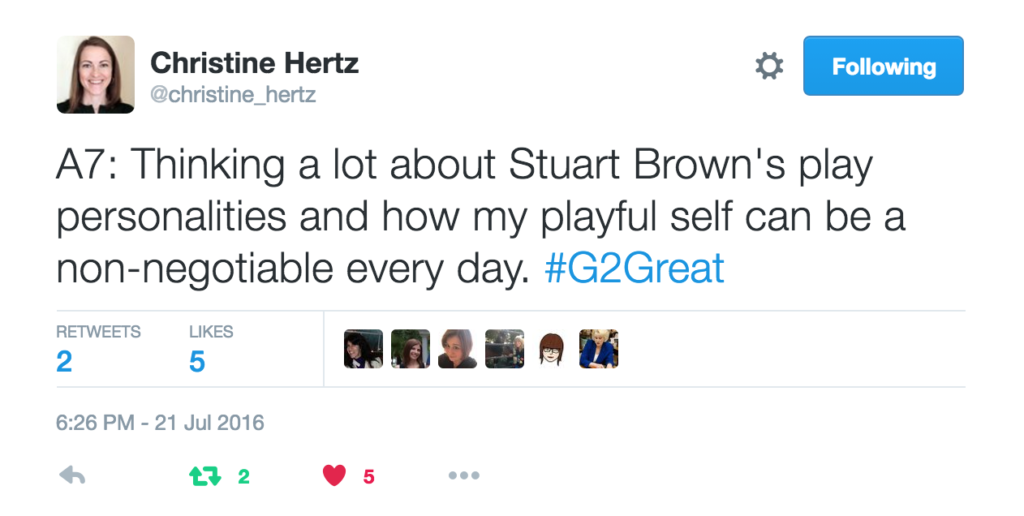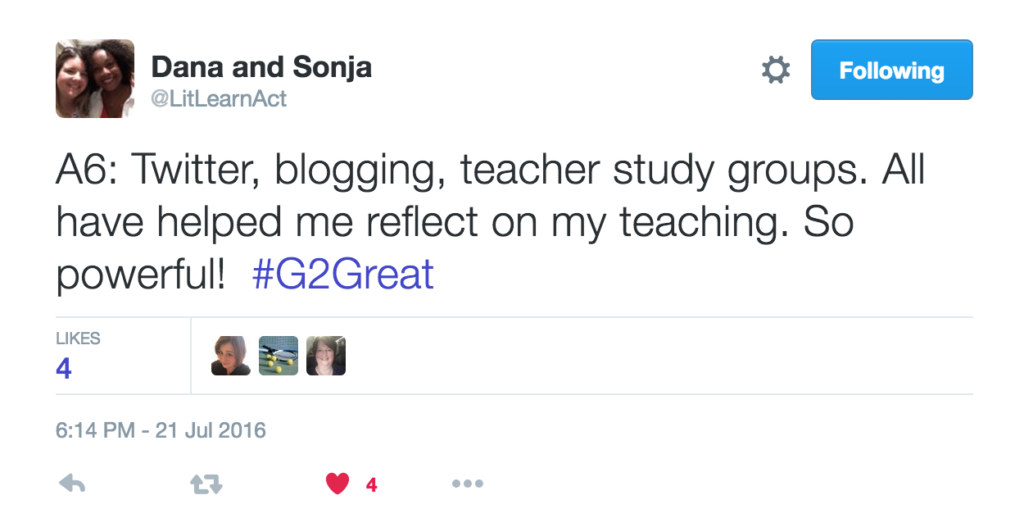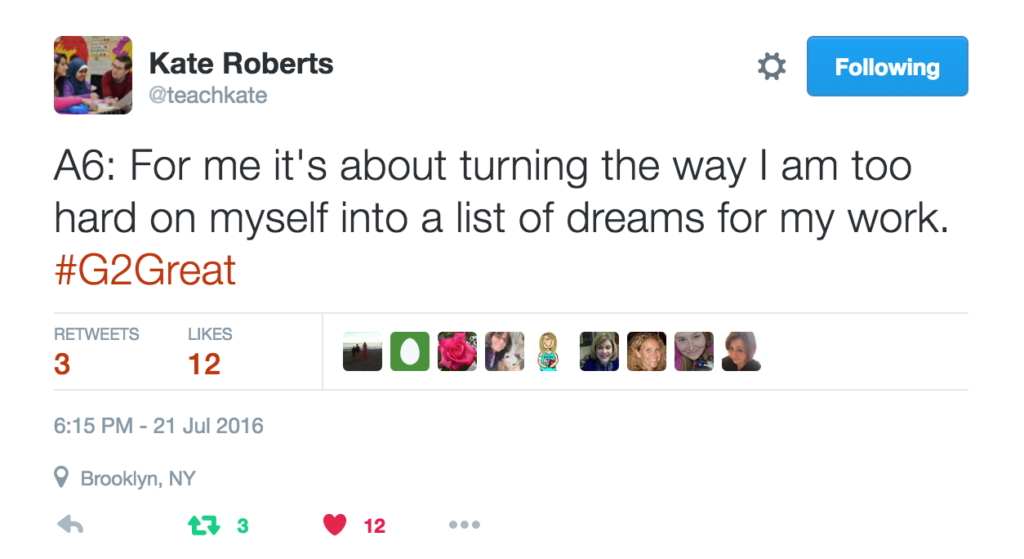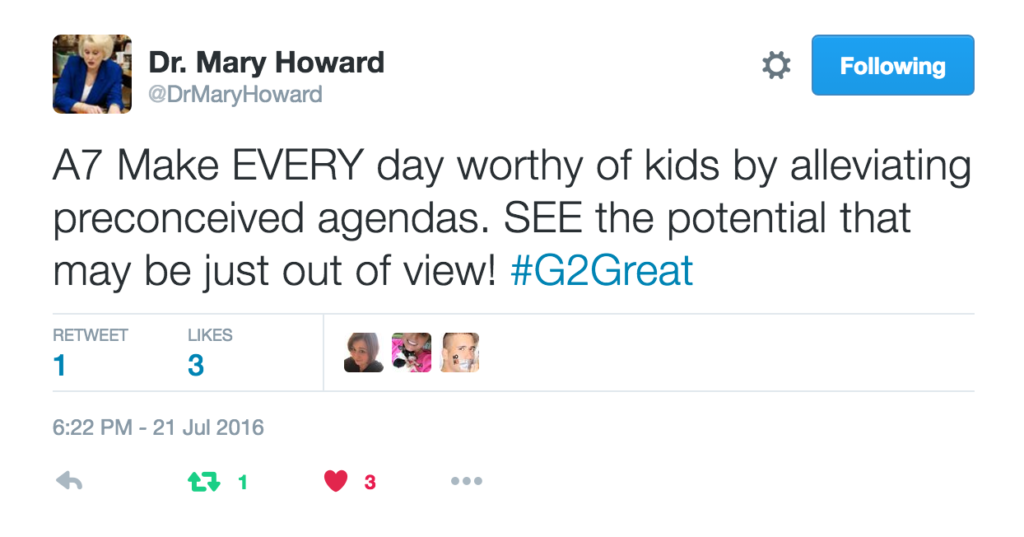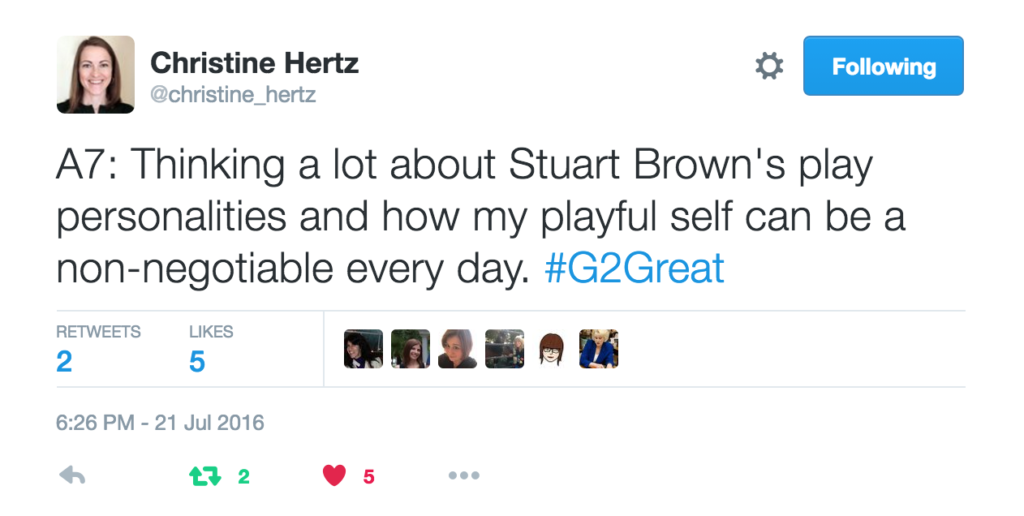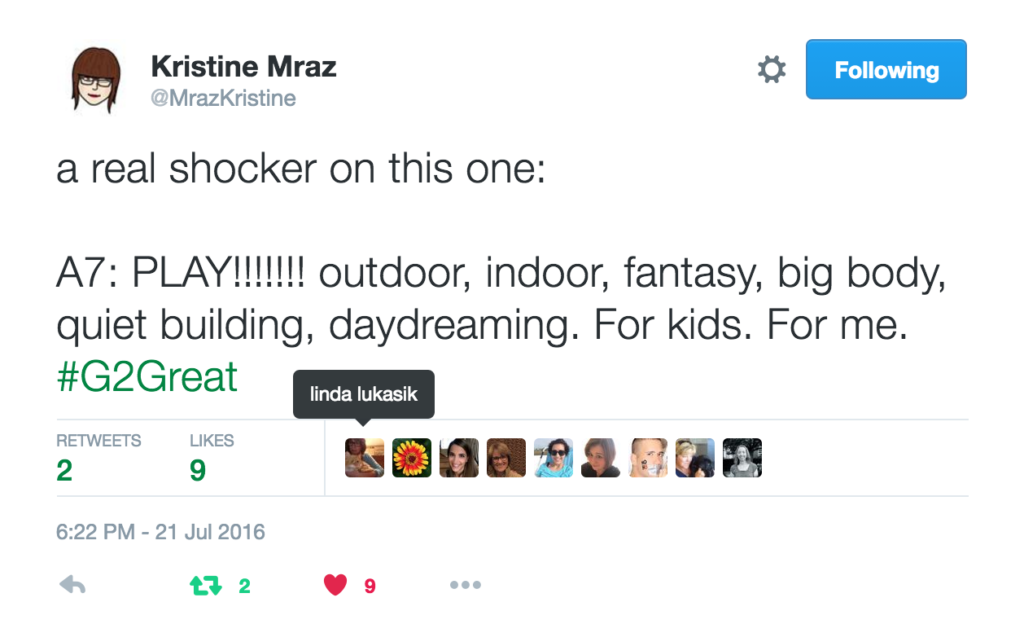by Mary Howard

On 8/4/16, #G2Great embarked on a new journey with a five-part leadership series. Exploring Seven Big Ideas to Maximize Schoolwide Potential is a virtual “celebration of administrators who model by their actions what is possible when we create a shared role of lead learner.
And celebrate possible we did when Seth Berg, principal of Meadow Brook Elementary in Rochester Hills, MI, launched us on a joyful exploration. I met Seth early in my entry into Twitter when I happened on his remarkable blog and I’ve been professionally smitten ever since. Seth lives and breathes the harmonious merger of administration and instruction in the name of children and his first tweet was a testament to his commitment for this shared role:
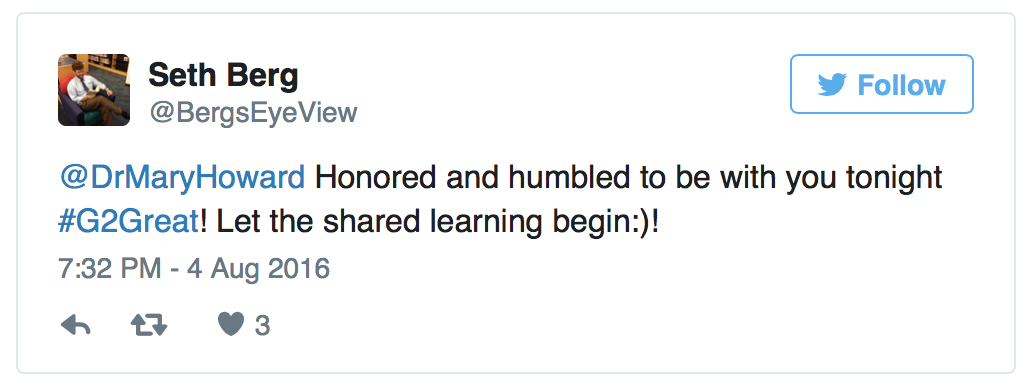 So as we begin our series, I’d like to reflect on Seth’s inspirational tweets that highlight our Seven BIG IDEAS. Notice that these ideas are not viewed in isolation but through a lens of deep beliefs interwoven into a beautiful patchwork of change:
So as we begin our series, I’d like to reflect on Seth’s inspirational tweets that highlight our Seven BIG IDEAS. Notice that these ideas are not viewed in isolation but through a lens of deep beliefs interwoven into a beautiful patchwork of change:
BIG IDEA 1: CREATING A SCHOOLWIDE CULTURE

It doesn’t take long after entering a school building to get a strong sense that a schoolwide culture has been thoughtfully nurtured within a collective spirit of commitment. Seth emphasizes that our core values, those things we hold dear supported by research, are at the center of this culture. Yes these are challenging times, but if we adhere to the tenets of what matters most in our schools and as we work toward a culture based on a common ground of excellence, that culture is palpable the moment you enter the front door. It is evident that these schools view time as a precious commodity as demonstrated by each minute spent in the most valuable and purposeful ways as positive energy literally emanates from every intentional choice in the service of learning.
BIG IDEA 2: BUILDING RESPECTFUL PROFESSIONAL RELATIONSHIPS
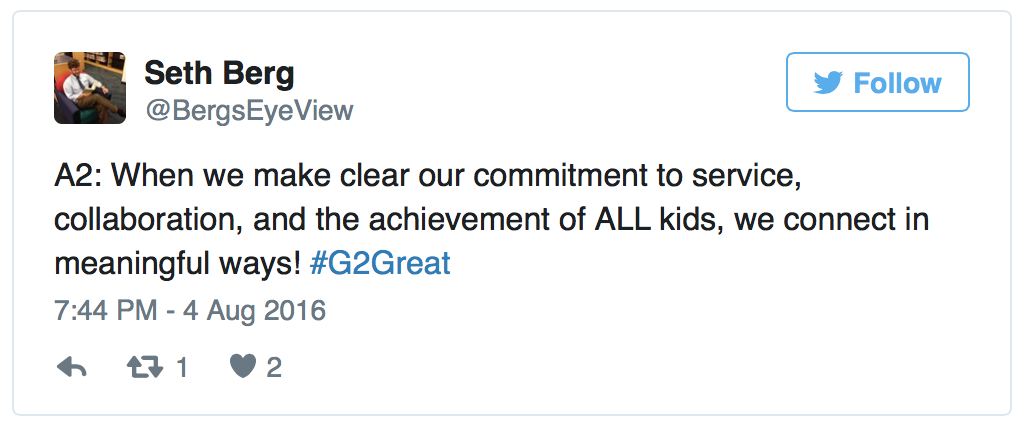
This schoolwide culture where core values are celebrated is rises from respectful relationships that nurture positive interactions. These relationships do not happen by chance or because teachers are expected to become compliant disseminators of top down mandates. Rather, it is an outcome of shared leaderships where each voice is viewed as key decision-maker within a positive environment where educators work together to bring a common vision for what that school can be to life. When this happens, the celebration of possible is always in view as shared ownership reflects collective input. Mutual respect then leads to even more productive efforts as this thoughtfully intentional work has a direct impact on students.
BIG IDEA 3: MERGING LEADERSHIP AND INSTRUCTION
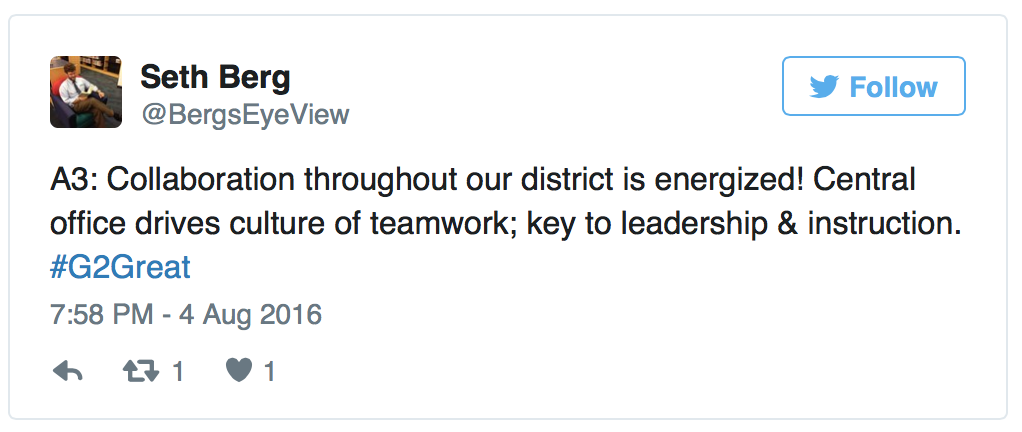
It is not unusual to see a negative trickle down effect in districts where leadership is seen through a lens of iron fisted directives. This same trickle down effect, however, becomes a positive force when shared leadership flows from a district to building level so administrators are empowered to do this work with support from all sides. Seth’s message of collaboration from a broader culture of leadership can have a significant impact on the collective energy across an entire district. The freedom that comes with this trust affords principals opportunities to promote and support change that is responsive to the unique needs of their individual buildings as schools set their sights on this staff, these students and this community. In other words, the leadership-instruction merger is not a recipe that is merely doled out to schools within the district to dutifully implement, but a collective willingness to address the most pressing needs of the individual school at that moment in time.
BIG IDEA 4: PROMOTING COORDINATION AND COLLABORATION
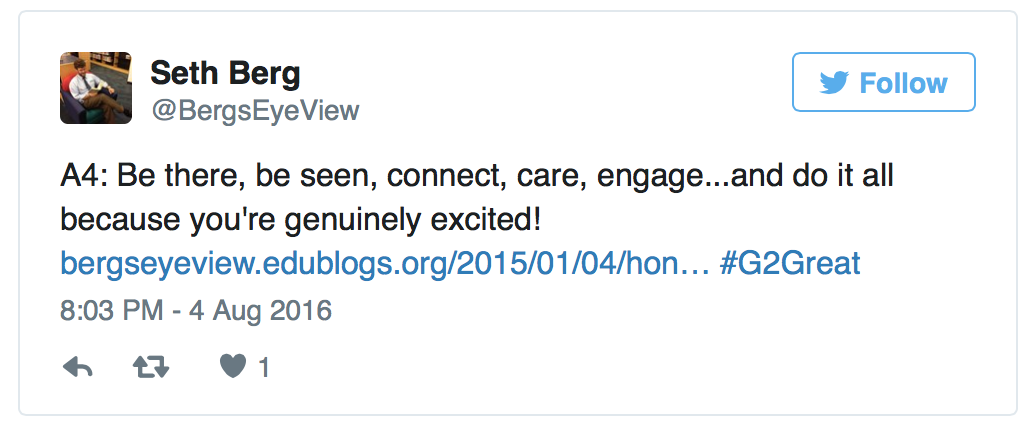
As an educator, I can’t think of anything I would want more than to be in an environment where everyone is present, visible, connected, engaged and above all enthusiastic. When we acknowledge that we are all working toward a common goal focused squarely on meeting the needs of students, great things can happen. Those critical qualities Seth referred to then become the fuel that has the potential to drive all we do. In order to merge leadership and instruction, we must be on the same page, coordinating our efforts through collaboration and an unwavering collective commitment to elevate the craft of teaching so that we can enrich the learning lives of the students we are fortunate to have in our care. Schools that place a high value on being present, visible, connected, engaged and enthusiastic view students as the impetus for every decision on a day-to-day, moment-to-moment basis.
BIG IDEA 5: CONNECTEDNESS TO COMMUNITY NEEDS
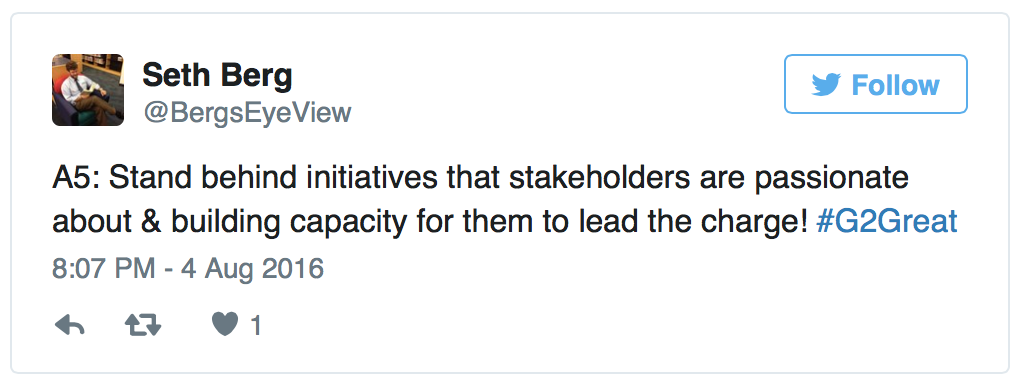
Schools do not exist on a lonely island in the middle of nowhere. Rather, they exist within a larger community of support where we can maximize our potential within and beyond the four walls of our buildings. This two-way perspective will require us to be cognizant of the needs of our community and willing to initiate invitations to celebrate side by side with us in any way we can. We do this through events at a building level or through social media as we share our efforts with others. When we are proud of what is happening in our schools we want to open our doors to enthusiastically share our successes. If we find that we are unwilling to share our efforts and open our doors, then we may need to take a long hard look at what we are doing and make the changes that will alter our perception of our school and reawaken pride in all that we do because we know our choices matter.
BIG IDEA 6: VALUING PROFESSIONAL LEARNING

Those of us who are committed to professional learning respect both our personal and professional efforts as a never-ending process. Our lead learner administrators work to promote a mindset of professional curiosity that enables every member of the staff to reflect on and respond to personal and schoolwide queries about the learning process so that we can meet the learning needs of every child we are blessed to have in front of us. This curiosity inspires us to embrace discovery as we seek to understand this wonderful work we do so that we can do it in the most effective ways. Seth’s reminder to tap everyone and celebrate both the individual and collective progress we make along the way is essential for promoting a growth mindset designed to benefit teachers and in turn the recipients of our every effort – kids.
BIG IDEA 7: LEAVING A LONG-TERM IMPACT

Seth’s final message brought us full circle back to celebrating possible. His commitment to his school is so inspiring but it is his obvious belief in his own role as learner that left a lingering impact in my head and heart days after our chat. That sense of joy was then multiplied by a second tweet that elevated my appreciation for Seth as lead learner even more.

Seth’s belief in the immense beauty of learning together and embracing these moments is what long-term impact is all about. To illustrate the message that left me smiling for days after our #G2Great chat, Seth shared a blog post that reflected his ponderings when his eyes happened on a weed that had gone unnoticed on his lawn:
“Beauty does seem to be in the eye of the beholder, and I believe that beauty does exist everywhere and in everything. So, it’s up to the beholder to live in such a way that beauty becomes apparent to others. What happens when educators lead in ways that expose beauty to those they serve? What happens when educators lead in ways that encourage students to appreciate the unique and amazing beauty within themselves? Take one more moment, look again, behold this weed, this nuisance, this lawn pest.
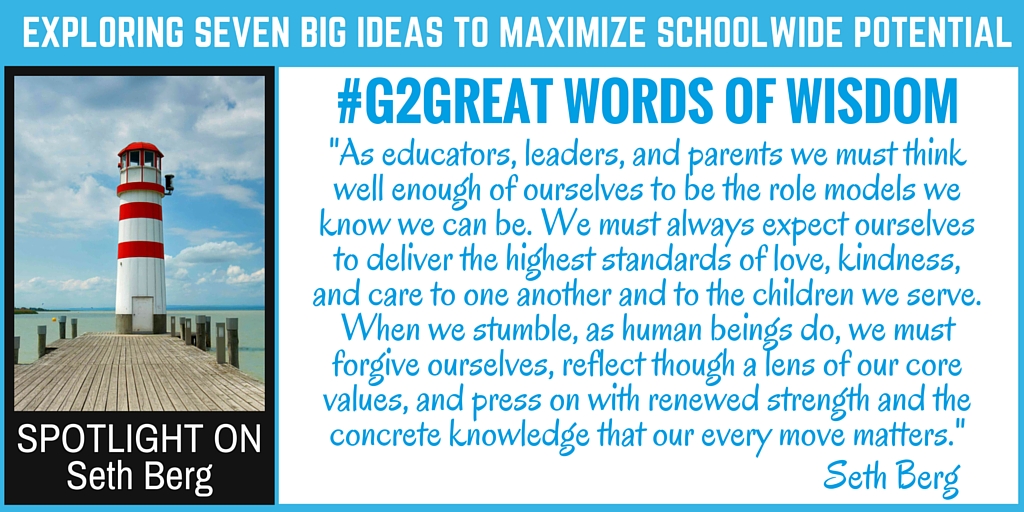
So as I look back on our celebration of possible through Seth’s eyes I am once again drawn to his eloquent words that move me to close with a question: When we know that schools like Meadow Brook Elementary with lead learners like Seth exist, why isn’t every school and every administrator celebrating the possible our teachers and students deserve? It occurs to me that anything less cheats teachers and children of the best we have to offer. Our students are an intricate thread that ties each of us together in a glorious joyful merger, and this powerful union of administration and instruction can take schools to new heights.
Maya Angelou once said, “Do the best you can until you know better. Then when you know better, do better.” We obviously know better because we have have seen possible at work in schools like Meadow Brook. Shouldn’t possible then be a professional and personal imperative for schools everywhere? It certainly seems like a question worth asking…
I, along with my #G2Great co-moderators Jenn Hayhurst and Amy Brennan, am so grateful to see a glimpse of lead learning in action at Meadow Brook Elementary. Thank you, Seth, for launching an inspiring journey celebrating possible through your eyes!
Please join #G2Great on 8/11/16 with guest host Matt Renwick, principal of Mineral Point Elementary in Mineral Point, WI.

